

What’s Next?
UGA researchers are tracking outbreaks of avian influenza


GUNNER STOCKTON
President Jere W. Morehead discusses how the University of Georgia prepares students for success.
across the UGA community.
Meet the creator of Hairy Dawg, a spacecraft developer for NASA, and the conductor of the USAF Band. All UGA alumni!
Get to know Lance Palmer, Janette McGarity Barber
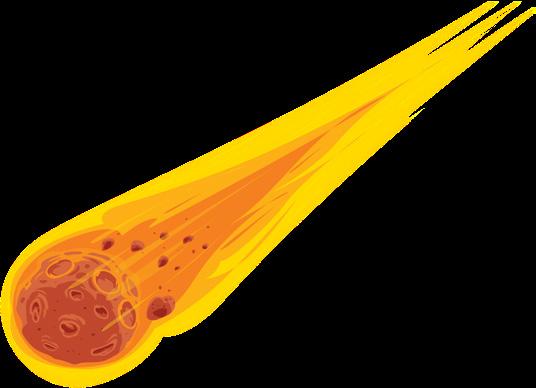

52 Strong
A Virus Takes Flight
The University of Georgia won its first national championship in 1942. Since then, the Bulldogs have collected 51 more in a variety of sports.
18 Out of This World
The story of how a meteorite fell from the sky and landed in a laboratory at the University of Georgia.
22 Where Coast Meets Classroom

From touch tanks to tidal creeks, the Marine Education Center and Aquarium on Skidaway Island immerses visitors in the science of Georgia’s coast.
A Virus Takes Flight
Avian influenza isn’t new. But the most recent outbreak’s rapid and prolific spread is setting off alarm bells for UGA researchers.
The H5N1 virus is a nasty customer, especially up close. Once it skyrocketed in wild bird populations, the idea of containing avian influenza became infinitely more complicated. This photo illustration by Georgia Magazine Art Director Lindsay Robinson gives readers an idea of what UGA researchers are dealing with.
Falling rocks, p. 18.
the UGA Marine Education Center and Aquarium on p. 22.


Stacked Up
BROWSING THE MAIN LIBRARY’S SHELVES, SEARCHING FOR research materials is as much of a tradition at the University of Georgia as Calling the Dawgs. Isabella Marcucci (foreground), a third-year human development major, and Presley Ford, a fourth-year double major in English and journalism, are hard at work renewing it.
CHAMBERLAIN

WINTER 2025
VOLUME 106 ISSUE NO. 1
GEORGIA MAGAZINE
Editor · Eric Rangus MA ’94
Associate Editors · Aaron Hale MA ’16 and Leigh Hataway MA ’17
Staff Writers · Cole Sosebee BS ’19, MA ’25, Jayne Roberts, Kristen Linthicum PhD ’18, Savannah Peat AB ’19, and Hannah Gallant
Art Director · Lindsay Robinson ABJ ’06, MPA ’11, MA ’22
Advertising Director · Kipp Mullis ABJ ’93
Photo Editor · Chamberlain Smith ABJ ’18
UGA Photographers · Andrew Davis Tucker and Dorothy Kozlowski BLA ’06, ABJ ’10
Contributing Writers · Elizabeth Elmore BBA ’08, ABJ ’08, Rachael Andrews BA ’17, MA ’21, Halleigh Woods AB ’22, and Ireland Hayes AB ’23
Contributing Designers · Andrea Piazza ABJ ’12, MA ’19, Whitney Mathisen, Kaiya Plagenhoef, Marisa Castengera, Jules Sherrill AB ’22, MA ’23 and Jonathan Duncan AB ’10
Editorial Interns · Caroline Newbern and Maura Rutledge
Research Writing Graduate Assistant · Sydney Barrilleaux BS ’24
MARKETING & COMMUNICATIONS
Vice President · Kathy Pharr ABJ ’87, MPA ’05, EdD ’11
Senior Director for Integrated
Media Communications · James Hataway MA ’10
Senior Executive Director for Operations & Fiscal Affairs · Fran Burke
Project Manager · Brittney Wurdeman
ADMINISTRATION
President · Jere W. Morehead JD ’80
Senior VP for Academic Affairs & Provost · Benjamin C. Ayers
VP for Finance & Administration · Ryan Nesbit MBA ’91
VP for Development & Alumni Relations · Jill S. Walton BSA ’99, MPA ’03
VP for Instruction · Marisa Anne Pagnattaro PhD ’98
Interim VP for Research · Christopher King
VP for Public Service & Outreach · Stacy Jones BSFCS ’93, EdD ’19
VP for Student Affairs · Michelle Cook
VP for Government Relations · Blake Raulerson AB ’14
VP for Information Technology · Timothy M. Chester
Senior Director for Marketing and Communications for Development and Alumni Relations · Lacey Creech
Change your mailing address by contacting e: records@uga.edu or ph: 888-268-5442
Find Georgia Magazine online at news.uga.edu/georgia-magazine
Submit Class Notes or story ideas to gmeditor@uga.edu
ADVERTISE in Georgia Magazine by contacting Kipp Mullis at e: gmsales@uga.edu or ph: 706-542-9877
FINE PRINT
Georgia Magazine (issn 1085-1042) is published quarterly for alumni and friends of UGA.
POSTMASTER | Send address changes to: University of Georgia
286 Oconee Street, Suite 200 North Athens, GA 30602

“UGA’s Active Learning initiative has transformed both our physical classrooms and the way our faculty teach courses to help students forge meaningful connections and engage more deeply in their studies.”
Preparing Students for Success
UGA initiatives benefit students on campus and set them up for tremendous careers after they graduate
The fall semester is a special time at the University of Georgia. Students return to campus, bringing enthusiasm and curiosity. Each year, new UGA students arrive more prepared than ever before. The talented Class of 2029 is no exception. In high school, these students took an average of 11 college-level courses, earned an average GPA of 4.17, and scored an average of 31 on the ACT and 1356 on the SAT. Georgia residents make up approximately 80% of the incoming class, and 215 of these students were high school valedictorians or salutatorians.
The University of Georgia is committed to providing these exceptional students with the best possible learning environment. Over the past 10 years, we have enhanced classroom instruction and introduced and expanded opportunities for academic engagement that prepare our students to embrace their roles as future leaders.
In 2016, UGA became the nation’s largest university to require experiential learning for all undergraduates, ensuring our students have access to hands-on learning experiences tied to their academic goals. Students study abroad, participate in service-learning, and complete internships—all while building critical thinking skills that help them succeed after graduation. UGA’s Active Learning initiative has transformed both our physical classrooms and the way our faculty teach courses, helping students forge meaningful connections and engage more deeply in their studies. This fall, we introduced the Comprehensive Learner Record, a novel digital credential that showcases students’ academic experiences alongside their extracurricular activities and developmental competencies. This innovative tool will help potential employers recognize our students’ abilities for leadership, communication, innovation, and more.
We are proud to see that these initiatives are preparing our students for success. UGA is one of only nine public universities in the U.S. with a 90% six-year graduation rate, and 95% of our students are employed or enrolled in graduate school within six months of graduation. As a result, the university’s world-class learning environment and commitment to student success continue to receive national recognition. We have been named one of U.S. News & World Report’s top 20 public universities every year for the last decade. Additionally, UGA rose in the 2026 Niche and Forbes rankings, where we were ranked 10th and 18th, respectively, among public universities. The future of the University of Georgia is incredibly bright, and we look forward to seeing all that our students and faculty will accomplish in the 2025-26 academic year.

Jere W. Morehead President
Bulldog Adventures




to
UGA Z
Art Restoration on Display
Paintings age over time, and once lively works of art can become cracked and faded.
This fall at the Georgia Museum of Art, the public got a glimpse of the revival of a 52-year-old abstract painting.
In an open-access lab created in the museum’s temporary exhibition space, Atlanta-based art
Highlights from across the UGA community

conservator Larry Shutts stabilized and cleaned Joan Mitchell’s Close, an abstract expressionist painting that’s been in the museum’s collection since 1974.
Close had cracking and lifting in areas where thickly applied oil paint dried out on the canvas. After stabilizing those areas, Shutts touched up spots where the dark green paint had already flaked off.
The public conservation project was funded by a grant from the Joan Mitchell Foundation in recognition of the Chicago-born artist’s 100th birthday.
“Conservation is often a silent work. It’s behind the scenes,” says Kathryn Hill, associate curator of modern and contemporary art and the driving force behind the museum’s grant application. “There’s a science to it, and this is a really lovely way of showing the public what we do in terms of caring for and protecting visual and cultural history.”
COLLECTING ACCOLADES
National Publications Give UGA Top Rankings
For the 10th consecutive year, the University of Georgia has placed in the top 20 among the nation’s best public universities, according to U.S. News & World Report ’s 2026 rankings. UGA shares the No. 19 rank with Purdue University.
The USNWR rankings echo recognition from earlier this year. UGA ranked No. 18 among public universities nationwide according to Forbes and moved into the top 10 national public universities ranking by Niche. UGA was also ranked No. 2 in the nation for best student life and No. 10 for best college campuses according to Niche. Additional accolades from Princeton Review include No. 12 among best value public schools, No. 8 for best alumni networks, and No. 10 for access to financial aid.
Several individual university programs received high marks in the USNWR rankings. The Terry College of Business rose to a record No. 19, up four from the previous year, for undergraduate business programs. Once again, the college’s insurance program ranked No. 1 in the nation. Terry’s real estate program was No. 4, its management and information systems program was No. 13, and the marketing program ranked No. 25.
UGA is one of only nine public universities in the U.S. with a 90% or higher six-year graduation rate. More than two-thirds of graduates remain in Georgia following graduation, and 95% are employed or continuing education within six months.
CATCH THE BUG
Invasive Spotted Lanternfly Poses New Threat to Georgia
A new invasive insect is trying to make Georgia its home—and the public’s help is critical to tracking the invasion, according to University of Georgia researchers.
The spotted lanternfly, an insect native to Asia, was first detected in Pennsylvania in 2014. Since then, lanternflies have steadily spread across the eastern United States and are now confirmed in 19 states.
With its striking bright spots and red patches, the spotted lanternfly might look like just another eye-catching insect. But don’t be fooled—it’s a serious threat.
The spotted lanternfly feeds on more than 70 plant species, including economically important hardwood trees, roses, hops, grapevines, and stone fruits such as peaches, plums, and cherries. It also excretes a sugary fluid called honeydew that can coat vegetation and surfaces, attracting black sooty mold growth.
The impact on Georgia’s agriculture, forestry, and nursery industries could be significant, posing a serious economic burden across multiple sectors.
If you spot a lanternfly, researchers ask that you snap a clear picture, smash the bug, and report the sighting through EDDMapS, the state’s official tool for lanternfly sightings. Areas near Fulton County remain at highest risk.
Welcome, Class of 2029
The incoming class of 2029 is one of the most academically qualified in UGA’s history.
The more than 6,200 first-year students have an average high school GPA of 4.17 and carry an average of 11 Advanced Placement, International Baccalaureate, or dual-enrollment courses. This marks the ninth


high school GPA of the incoming class exceeds 4.0.
Approximately 80% of the firstyear students are Georgia residents, a percentage far above that of many other state flagship institutions in the country. The incoming class includes students from 463 Georgia high schools, 142 Georgia counties (out of 159), 45 states, and 15 nations. More than 2,050 transfer students also are beginning their studies at UGA, meeting the university’s goal of enrolling one transfer student for every two new first-year students across the most recent spring, summer, and fall semesters.
MAKEOVER TIME
UGA Bookstore Debuts a Fresh Look
UGA’s on-campus bookstore has a fresh look: sleek, modern, and wrapped from floor to ceiling in red and black.
Located in the heart of campus, the UGA Bookstore is the headquarters for student course materials and the largest source of licensed UGA merchandise and gifts. Following an extensive remodel that was completed in time for the start of the fall semester, Bulldog fans now enjoy a dedicated game day shop; a special UGA-themed area; and a name, image, and likeness customization center.

The bookstore’s ground floor layout was redesigned in the remodel to improve flow on
The expanded course materials section on the top floor now spans more than an integration personalized list of textbooks and other materials needed for their courses.
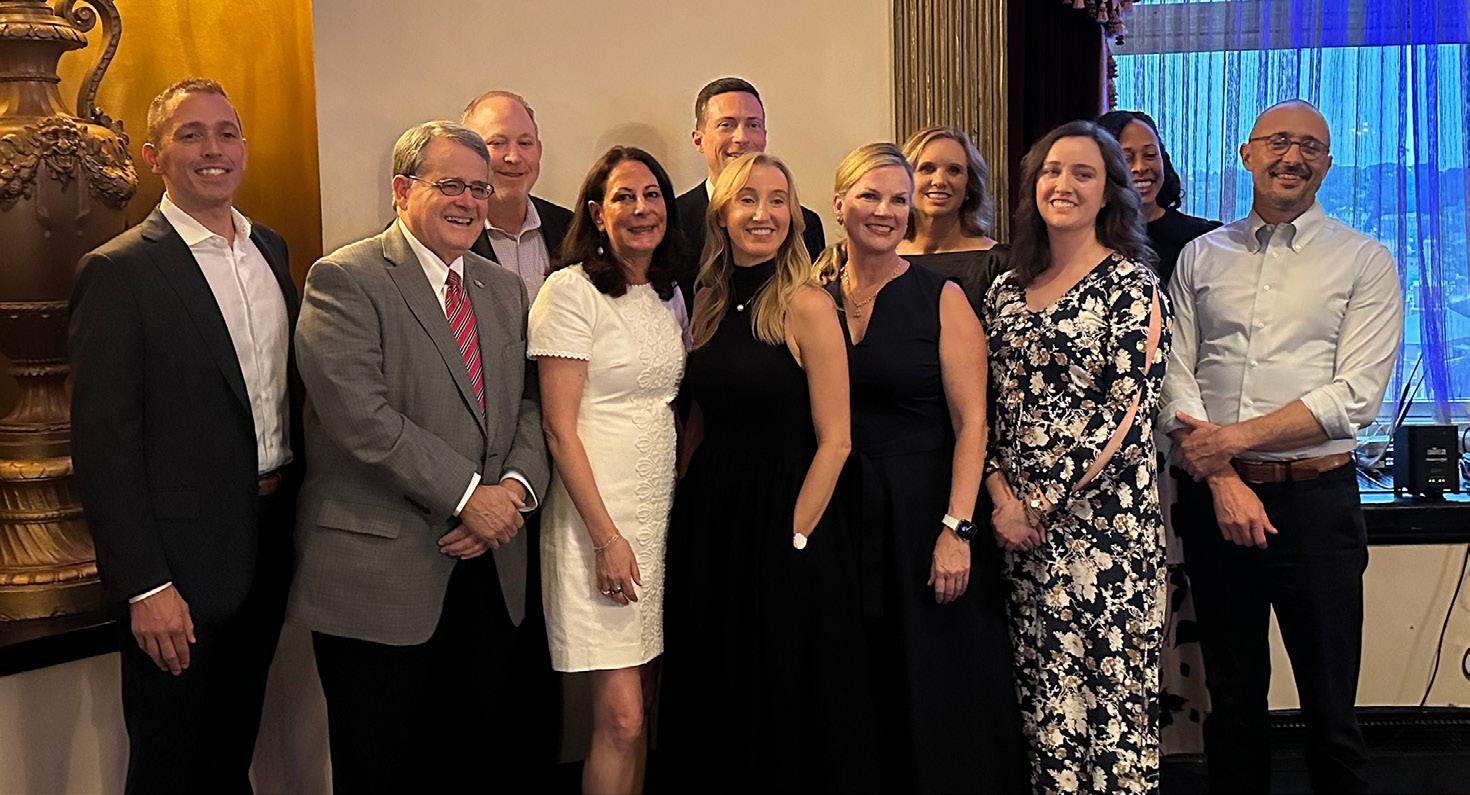
President Jere W. Morehead celebrates with UGA Legal Studies colleagues after receiving the Distinguished Career Achievement Award from the
UGA President Earns Career Honor

The UGA Bookstore’s business partner, Follett Higher Education, provided most of the funding for the project. Follett has partnered with UGA to operate the bookstore since fall 2003.
SERVING THE STATE
School of Nursing
Approved at UGA
The University System of Georgia (USG) Board of Regents, in May, authorized the establishment of an independent School of Nursing at the University of Georgia. Since the announcement, the USG system office and UGA have worked
The Academy of Legal Studies in Business presented President Jere W. Morehead JD ’80 the Distinguished Career Achievement Award during its annual conference this summer.
The award recognizes academy members who serve as exemplars of excellence in the fields of business law and/or ethics throughout their careers. Joan Gabel JD ’93, chancellor of the University of Pittsburgh, presented the award to Morehead at the academy’s annual conference.
Under Morehead’s leadership, UGA launched the nation’s largest experiential learning initiative, expanded small class offerings, and created the Double Dawgs program, enabling students to earn dual degrees in five years. The Active Learning initiative, driven by Morehead, has further modernized instruction, benefiting more than 78,000 students across campus.
Morehead’s career-long contributions to the legal studies in business discipline are grounded in decades of teaching, mentorship, and curriculum development. In 2001, he was named Meigs Professor of Legal Studies, earning UGA’s highest recognition for exemplary classroom teaching. He has served as editor-in-chief of the American Business Law Journal and currently serves as advisory editor. He also served as a panelist on the “Blue Ribbon Report on the Future of the Discipline” at the 2024 Academy of Legal Studies in Business Annual Conference.
together to develop a comprehensive plan for the school’s development.
“The UGA School of Nursing will advance our institution’s commitment to addressing the health care needs of all Georgians, provide educational opportunities sought by our students for many years, and develop a community of scholars equipped to prepare the next generation of nurses,” says President Jere W. Morehead JD ’80
To meet the demands of the state’s surging population, Georgia needs more
nurses and more nursing faculty. To address these challenges, the Board of Regents recommended that the UGA School of Nursing initially offer a Bachelor of Science in Nursing and offer a Master of Science in Nursing and a Doctor of Nursing Practice soon after.
UGA will work with leaders at Augusta University in developing the UGA School of Nursing in Athens. The UGA School of Nursing could launch as early as fall 2027.
LIFETIME ACHIEVEMENT
Academy of Legal Studies in Business.

Curbing the Certified Nursing Assistant Shortage
As the American population ages, the nation faces a crisis in its long-term care system—a shortage of certified nursing assistants (CNAs).
A new study from the College of Public Health suggests that a lack of resources and advancement opportunities may be exacerbating the problem.
CNAs make up about one-third of all staff in nursing homes. But they provide about 90% of direct care, from helping with eating, bathing, and mobility, to providing companionship and monitoring for signs of illness.
And the number of CNAs is dwindling.
“I don’t think most people realize what a CNA does on a day-to-day basis, how oftentimes they are really the go-to person for nursing home residents,” says Curt Harris PhD ’08, co-author of the study and the director of the College of Public Health’s Institute for Disaster Management.
The study identifies challenges in compensation, recruitment, and retention as key factors in the shortage. Direct resident care can take a physical and emotional toll, Harris says, and CNAs often lack access to mental health resources.
The researchers recommended improved access to training, opportunities for career advancement, and pay increases to alleviate the shortage in CNAs.
YOU CAN SKIP THE CANDLELIGHT
It’s the Person, Not the Place on First Dates
Dinner and a movie. Bowling. Hiking. A cup of coffee. There are so many options for where to go for a first date. But each of them comes with the worry: Is this going to go well?
It turns out location isn’t a dealbreaker, though, according to new research from the University of Georgia.
Researchers randomly paired up 200 strangers in two different first-date environments (one room with comfortable furniture, decorations, and nice lighting versus a space with white cement walls, old wooden chairs, and junk lying around). The couples who met and talked in the plain space didn’t let that kill the vibe. Connections formed the same in both rooms.
The findings offer hope to people stressing about a first-date location. The romance will speak for itself.
“Stress less on where the first date might take place and try to focus on how you can create a space for openness and vulnerability through that dialogue,” says Daisi Brand MS ’23, the lead researcher and a graduate student in the Department of Psychology. “When trying to form those early steps of closeness and connection, that conversation is so important. Be ready to ask meaningful questions and learn more about this person.”
Binge-Watching May Have Benefits
If you’re a binge-watcher, you’ve probably said, “Just one more episode,” a thousand times over.
And though binge-watching may seem like a bad habit, a new study from the University of Georgia suggests there may be some benefits to not turning off the tube.
If you often find yourself watching episode after episode, it may be harder for a story to leave your head, the researchers say. But that’s not necessarily a bad thing.
The study found people who marathon movies, shows, or books are more likely to remember stories and keep engaging with them through daydreams and fantasies.
“Humans are storytelling creatures,” says Joshua Baldwin, lead author of the study and postdoctoral researcher in the Grady College of Journalism and Mass Communication. “One of the functions of narratives is the ability to satisfy motivations for things like connecting with other people, feeling autonomous and confident, and even security and safety.”

Binge-watching may help make stories more memorable by helping viewers connect plot threads and come away with a bigger picture of the story. This is especially true for longer series, with lots of different plotlines and characters to follow.
The study suggests binge-watchers are more likely to think about stories they’ve finished than people who consume media more slowly.
Binge-watching may help viewers build mental worlds where stories continue even after finishing a series. And these tales may help them cope in times of stress.





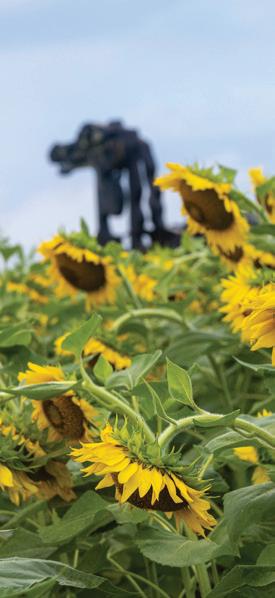



scholarship and storytelling meet. The 2025 issue highlights how the University of Georgia College of Agricultural and Environmental
From research breakthroughs to alumni successes, each page offers a glimpse of agriculture as both art and science — rooted in tradition and driven by discovery. These stories offer a window into the promise of agricultural innovation and an invitation to share the college’s vision of a thriving, resilient world — of science in service of humanity and the environment. For the digital edition, scan the QR code or visit almanac.caes.uga.edu.

OPENING DOORS, REMOVING BARRIERS
Donor-supported scholarships empower students to lead, discover, and serve.

The University of Georgia and its donors are committed to supporting the entire student experience by providing scholarships that recruit the best and brightest to enroll at UGA, help students overcome financial barriers, enhance in-classroom learning, and assist them in seeing the world.
Students who are financially stable are able to fully embrace UGA’s dynamic learning environment, pursue leadership opportunities, and make the most of their time on campus.
When the UGA community rallies together, they’re not just funding an education. They’re investing in the next generation of Bulldogs and the future of the state and the world.
Merit-based Scholarships
UGA offers an expansive portfolio of merit-based scholarships to recognize academic excellence and leadership. Many of these donor-funded scholarships support thousands of students each year with awards that often include tuition support, stipends,
and experiential learning opportunities to support the total cost of attendance. In the 2024-2025 academic year, over 8,000 students were awarded more than $27 million in donor-funded, merit-based scholarships.
One such merit-based scholarship is the Foundation Fellowship, UGA’s premier academic scholarship. The Foundation Fellowship gives students the freedom to pursue internships, research, mentoring relationships, and hands-on learning opportunities to enrich their educational experience.
Need-based Scholarships
With need-based scholarships, the Bulldog community can bridge the funding gap for students whose circumstances make a quality education appear out of reach. In 2024, UGA donors helped the university surpass 1,000 endowed, need-based scholarships for talented students who pursue education in the face of financial strain.
In the 2024-2025 academic year, UGA awarded more than $9 million in need-
based aid, impacting almost 3,000 students. For Georgia residents, the average cost of attendance at UGA is $29,566 per year.
Even after receiving the Federal Pell Grant and other financial aid, students from the lowest income backgrounds still face an annual unmet need of approximately $10,228. Need-based scholarships play a critical role in bridging this gap by opening lasting pathways to higher education for both current and future Bulldogs.
Experiential Learning Scholarships
Experiential learning is required for all UGA students, and these scholarships aim to ensure that all Bulldogs have the opportunity to gain new perspectives and experiences through hands-on learning. Individual donors and giving societies can prioritize their giving toward supporting opportunities for students to study away, and take on internships, leadership experiences, research opportunities, service-learning, and creative programs.
EDWIN HAMMOND

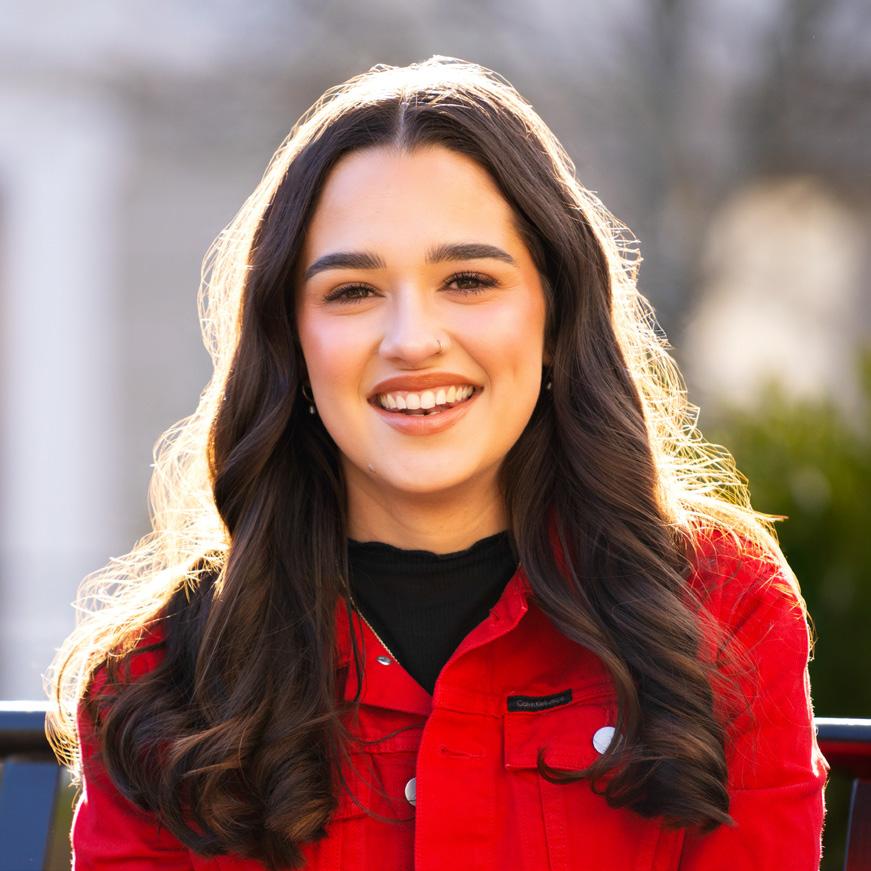
“What our donors have done for these students is life changing, and the effects extend to the students' families and communities.”
– Jill S. Walton BSA ’99, MPA ’03, Vice President for Development and Alumni Relations

“Receiving a scholarship has given me a sense of freedom and control over my story. It’s amazing to think that these scholarships have provided other students that same freedom and hope for the future.”
HAILEY COVARRUBIAS, FOURTH-YEAR STUDENT, SCHOLARSHIP RECIPIENT
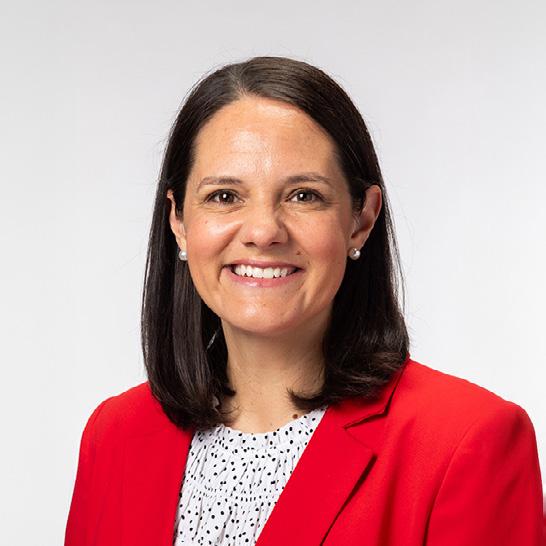
“Giving back is a really personal thing, so you have to figure out what you’re passionate about and how to make sure it impacts as many people as possible.”
– Johnelle Simpson II AB ’16, BBA ’16, Donor and Former Recipient of the Let All the Big Dawgs Eat Scholarship
“I wanted to provide students handson resources and access in the hopes of inspiring students on their own journeys to fulfill their dreams, just like I was able to.”
– Anne Barge Clegg BSEd ’69, Alumna and Donor

ENDOWING SCHOLARSHIPS
Individuals who are interested in supporting scholarships have a variety of options—from pledges to estate gifts and one-time contributions of any size. Many donors choose to establish a legacy by endowing a scholarship. Gifts to support endowments are invested to maximize an annual return and create income that funds the scholarship in perpetuity.
The minimum donation to endow a scholarship through the UGA Foundation is $50,000, but that amount isn’t expected all at once. A multiyear pledge is the standard, with contributions spread out over several years to make participation more manageable.
You can open doors for the next generation of Bulldogs by investing in scholarships that change lives. GIVE.UGA.EDU/COMMIT

52 Strong A History of Georgia’s National Championships
WRITTEN
BY
AARON HALE MA ’16
PHOTOS BY UGA ATHLETICS AND DIVISION OF MARKETING & COMMUNICATIONS STAFF
The University of Georgia opened the 2024-2025 academic year on the precipice of 50 national championships in all sports at 48. And then the Bulldogs went to work collecting banners.
First came another equestrian championship. And then one in women’s indoor tennis, followed by another in outdoor tennis. And once the Georgia women’s outdoor track and field squad ran away with the team title in Eugene, Oregon, the Georgia Bulldogs had 52 total team national championships.
The 2024-2025 academic year marked one of Georgia Athletics’ best, tying the school record of four national championships. The other was 1999.
The Bulldogs’ 52 national championships are spread across eight sports with women’s sports claiming 34 of them.

Equestrian
Since Georgia’s equestrian program began, it has been a national leader in the sport, winning eight National Collegiate Equestrian Association titles. The first championship came in the program’s first season of competition in 2003, and the latest title came last season with a victory in the finals over SMU.
MEN’S Tennis
Over the years, Georgia has consistently been a powerhouse in tennis, thanks in part to the Dan Magill Complex, one of the best on-campus tennis facilities in the nation. The men’s tennis team has won eight national titles, including two indoor championships. The program strung together four consecutive total titles from 2006 to 2008.
woMEN’S Tennis
UGA women’s tennis is historically one of the top programs in the nation, amassing eight total team titles. That includes the indoor and outdoor championships in 2025 keyed by Dasha Vidmanova BBA ’25, who won an NCAA team, singles, and doubles national championship during her collegiate career.
BASEBALL
By some accounts, baseball is the oldest varsity sport in UGA history, with its first season coming in 1886. The team won its lone NCAA championship in 1990 with a crew of veteran players. The team actually lost five consecutive games to end the regular season but still got an invitation to the NCAA tournament, which led to victory in the College World Series over the favored Oklahoma State Cowboys. Georgia became the first SEC team to win the College World Series.


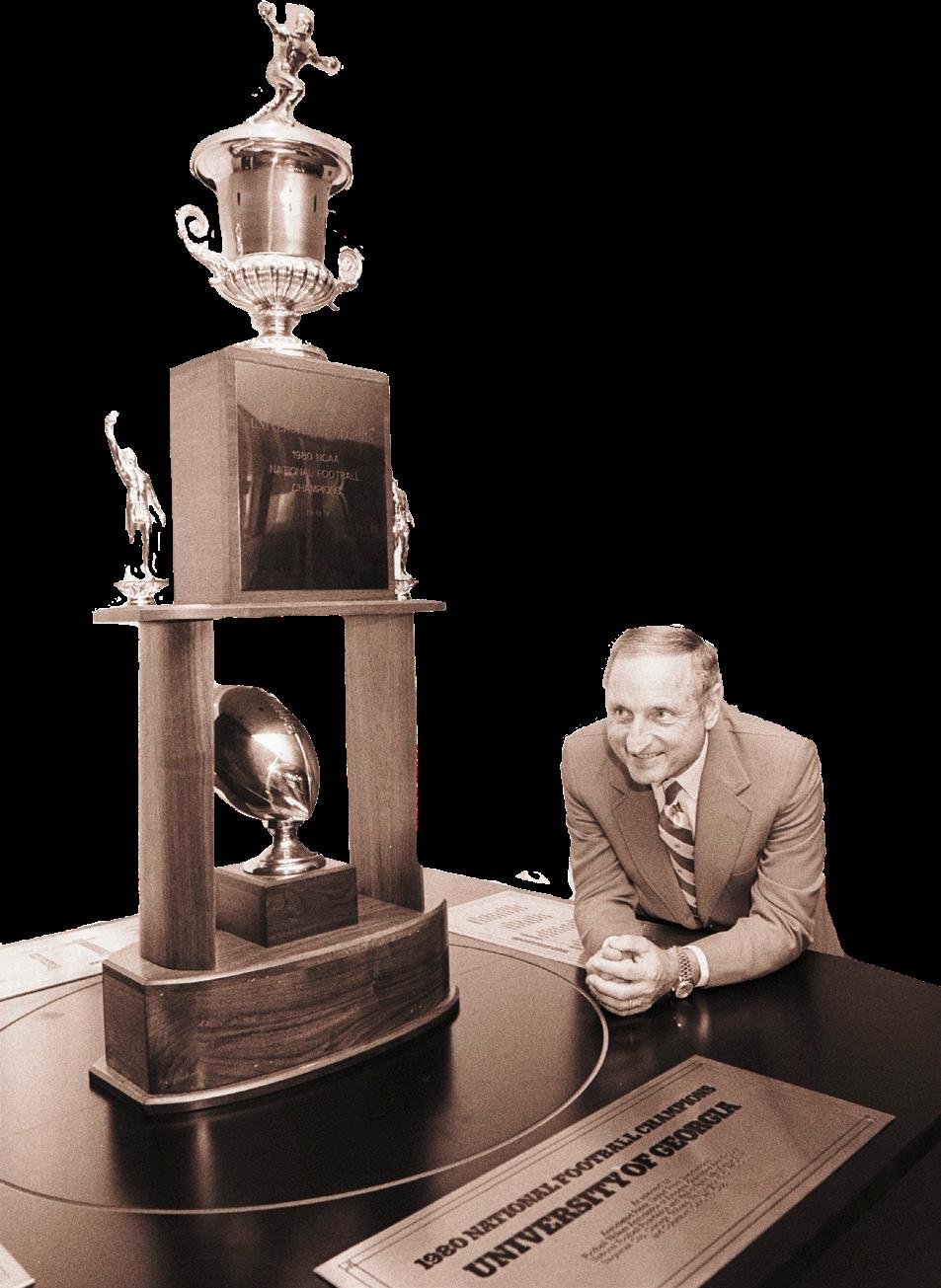
Football MEN’S GOLF
The 1942 Bulldogs went 11-1 and beat UCLA in the Rose Bowl. Six of the major polls named the Bulldogs No. 1 at season’s end, but the university didn’t claim the title until the 1990s.
The Dawgs wouldn’t win another team national championship in any sport until the 1980 season under Coach Vince Dooley. More recently, Kirby Smart’s BBA ’98 Dawgs went back-to-back in 2021 and 2022.
Women’s Swimming and Diving
The women’s swimming program was only a few years old when Jack Bauerle AB ’75 took over as head coach in 1979. In his time, Bauerle’s Lady Bulldogs teams produced seven NCAA championships and 12 SEC titles. Bauerle also mentored 97 Olympians, who collectively earned nearly 40 medals.
Gymnastics
Gymnastics leads Georgia programs in national championships with 10, all under legendary former head coach Suzanne Yoculan. The program won its first title in 1987 in Salt Lake City, and its second came two years later in Athens. That success carried into the 1990s with three championships. The Gym Dawgs reached even higher heights in the early 2000s, rolling off five consecutive championships from 2005 to 2009.
The Bulldogs golf program dates to the 1920s, when teams didn’t have coaches but players who served as captains. The first men’s national title came in 1999, the second in 2005.
WOMEN’S GOLF
The women’s golf team began in 1967. Since then, three Bulldogs have won individual titles. The women’s team earned the national title in 2001.
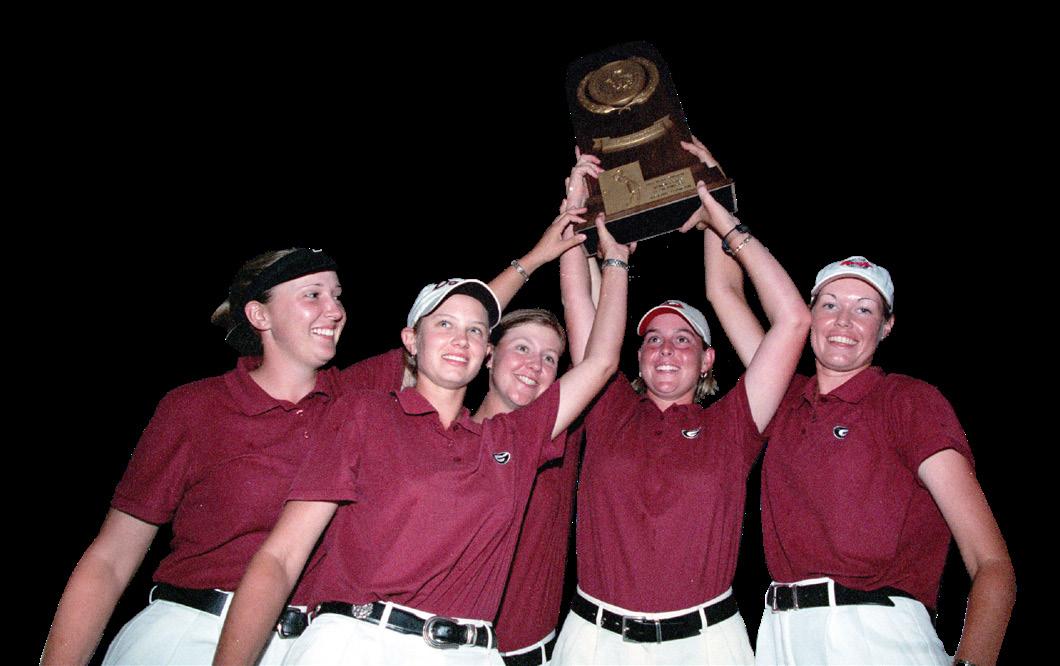
Men’s Track AND Field
Track and field is one of the handful of varsity sports dating back to the 19th century. The program has produced numerous individual national champions and Olympic medalists, beginning with Georgia track star Spec Towns BSEd ’37, who won a 1936 Olympic gold medal and high hurdles championships in 1936 and 1937. The Bulldogs men’s track and field team won the national championship in 2018.

n’s Track ield
Like the men’s team, the women’s track and field unit has earned plenty of individual honors. Sprinter Debbie Ferguson-McKenzie BS ’00 is a five-time Olympian and a three-time medalist, including one gold, for the Bahamas. She won four individual national championships with the Bulldogs. The women’s team won the indoor national championship in 2018 and the 2025 outdoor







1940s
1942 - Football

1980s
1980 - Football
1985 - Men’s Tennis
1987 - Gymnastics, Men’s Tennis
1989 - Gymnastics
The Bulldogs won consecutive national championships in football in 2021 and 2022, a feat accomplished by just one other university in the last 25 years.
1990s
1990 - Baseball
1993 - Gymnastics
1994 - Women’s Tennis, Women’s Tennis (Indoor)
1995 - Women’s Tennis (Indoor)
1998 - Gymnastics
1999 - Men’s Golf, Gymnastics, Women’s Swimming and Diving, Men’s Tennis

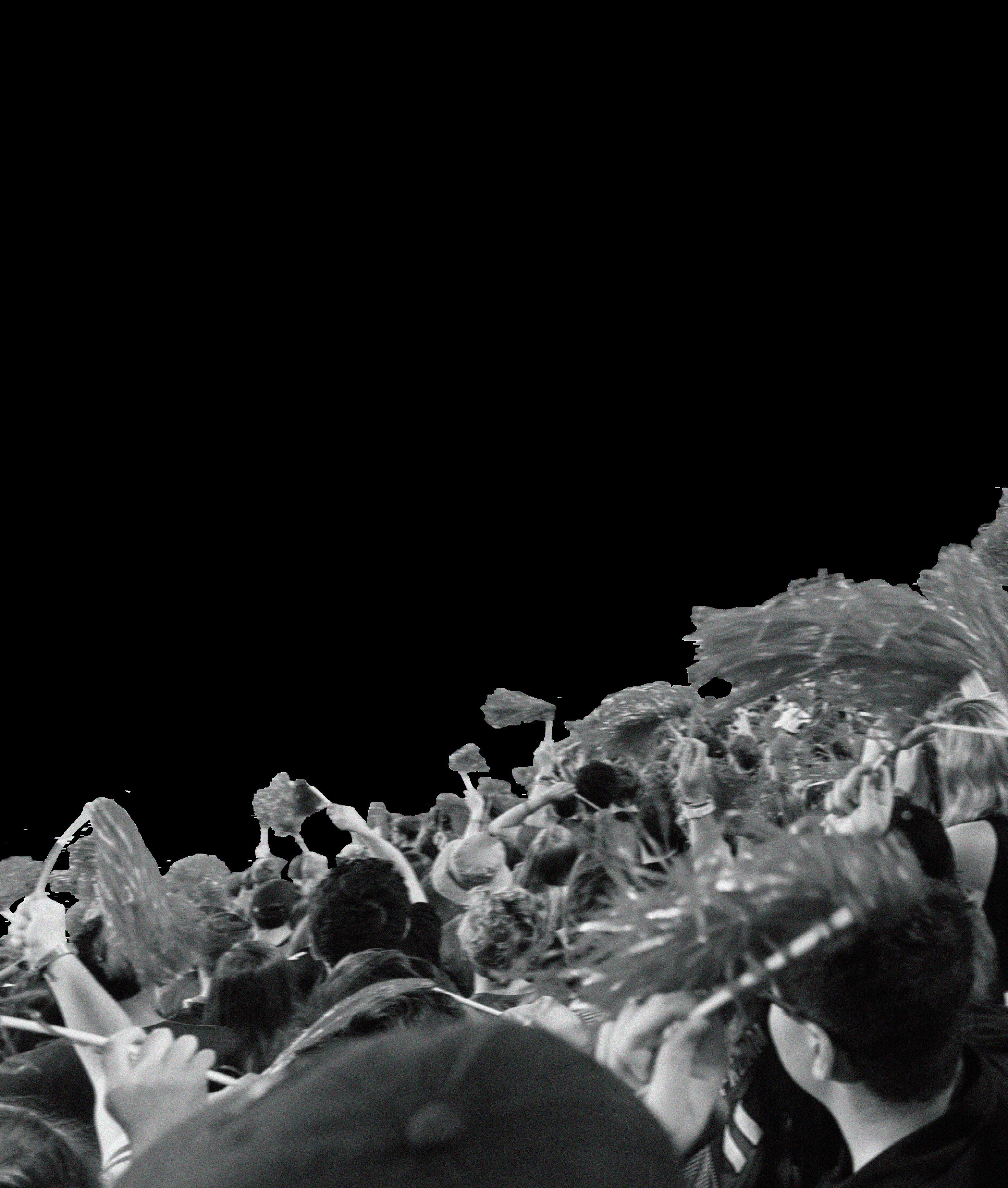



2000s
2000 - Women’s Swimming and Diving, Women’s Tennis
2001 - Women’s Golf, Women’s Swimming and Diving, Men’s Tennis
2002 - Women’s Tennis (Indoor)
2003 - Equestrian
2004 - Equestrian
2005 - Men’s Golf, Gymnastics, Women’s Swimming and Diving
2006 - Gymnastics, Men’s Tennis (Indoor)
2007 - Gymnastics, Men’s Tennis, Men’s Tennis (Indoor)
2008 - Equestrian, Gymnastics, Men’s Tennis
2009 - Equestrian, Gymnastics

2010s
2010 - Equestrian
2013 - Women’s Swimming and Diving
2014 - Equestrian, Women’s Swimming and Diving
2016 - Women’s Swimming and Diving
2018 - Men’s Track & Field (Outdoor), Women’s Track & Field (Indoor)
2019 - Women’s Tennis (Indoor)

2020s
2021 - Equestrian, Football
2022 - Football
2025 - Equestrian, Women’s Tennis, Women’s Tennis (Indoor), Women’s Track & Field (Outdoor)



Out of This World
WRITTEN BY SAVANNAH PEAT AB ’19
CHAMBERLAIN SMITH
These fragments of the 4.5 billion-year-old McDonough Meteorite, which tore through the roof of a Georgia home, provide scientists with an excellent opportunity to study the space rock’s unique composition.
It came from outer space and crash-landed in a Georgia living room.
June 26 started out as a pretty normal, work-from-home day for a McDonough man. Then, while on a Zoom call, he heard a boom and felt a vibration equivalent to a close-range gunshot.
A meteorite blasted through his roof and HVAC duct and embedded itself into the floor. But the man didn’t lose his cool. Instead of panicking over the golf ball-sized dent the space rock made, he grabbed his phone and called Scott Harris.
“I suspect that he heard three simultaneous things. One was the collision with his roof, one was a tiny cone of a sonic boom, and a third was it impacting the floor all in the same moment,” says Harris, a visiting scholar in the University of Georgia Franklin College of Arts and Sciences’ Department of Geology. “There was enough energy when it hit the floor that it pulverized part of the material down to literal dust fragments.”
The homeowner, who prefers not to be identified, found himself with a living room full of space dust to vacuum. But he provided fragments to Harris so the researcher could determine the meteorite’s origin and classification.
Turns out, it has quite the past.
It’s ƒ Bird! It’s ƒ Plƒne!
it’s…
Before the McDonough Meteorite landed in Henry County, it streaked across the daytime sky as a fireball (otherwise known as a bolide).
Researchers clocked the meteorite entering the atmosphere at cosmic velocity. Before it split apart, the meteorite was the size of a vending machine hurtling toward McDonough faster than the speed of sound.
The remaining fragments are only about the size of a cherry tomato. But those fragments shot toward Earth at 1 kilometer per second. (That’s about 10 Dooley Fields each second.)
It was serendipitous that the homeowner was something of a scientist himself. He was more than happy to send all 23 grams to UGA for analysis.
Harris was out of town when he got the call to study the remains. He hightailed it back to Georgia.
“I was really interested in being able to examine that piece but also the dynamics of how it went through that house,” he says. “I couldn’t wait to get back.”






The McDonough Meteorite may be roughly the size of a cherry tomato, but this chunk traveled fast enough at an angle that it was able to blast through a homeowner’s roof, ductwork, and ceiling.

Out of this world history
The meteorite hails from a group of asteroids that make up a belt between Mars and Jupiter. That group broke from a much larger asteroid about 470 million years ago.
So how did the McDonough Meteorite end up all the way down here?
“In that breakup, some pieces get stuck in Earth’s orbit, and if given long enough, their orbit around the sun and Earth’s orbit around the sun end up being at the same place, at the same moment in time,” Harris says.

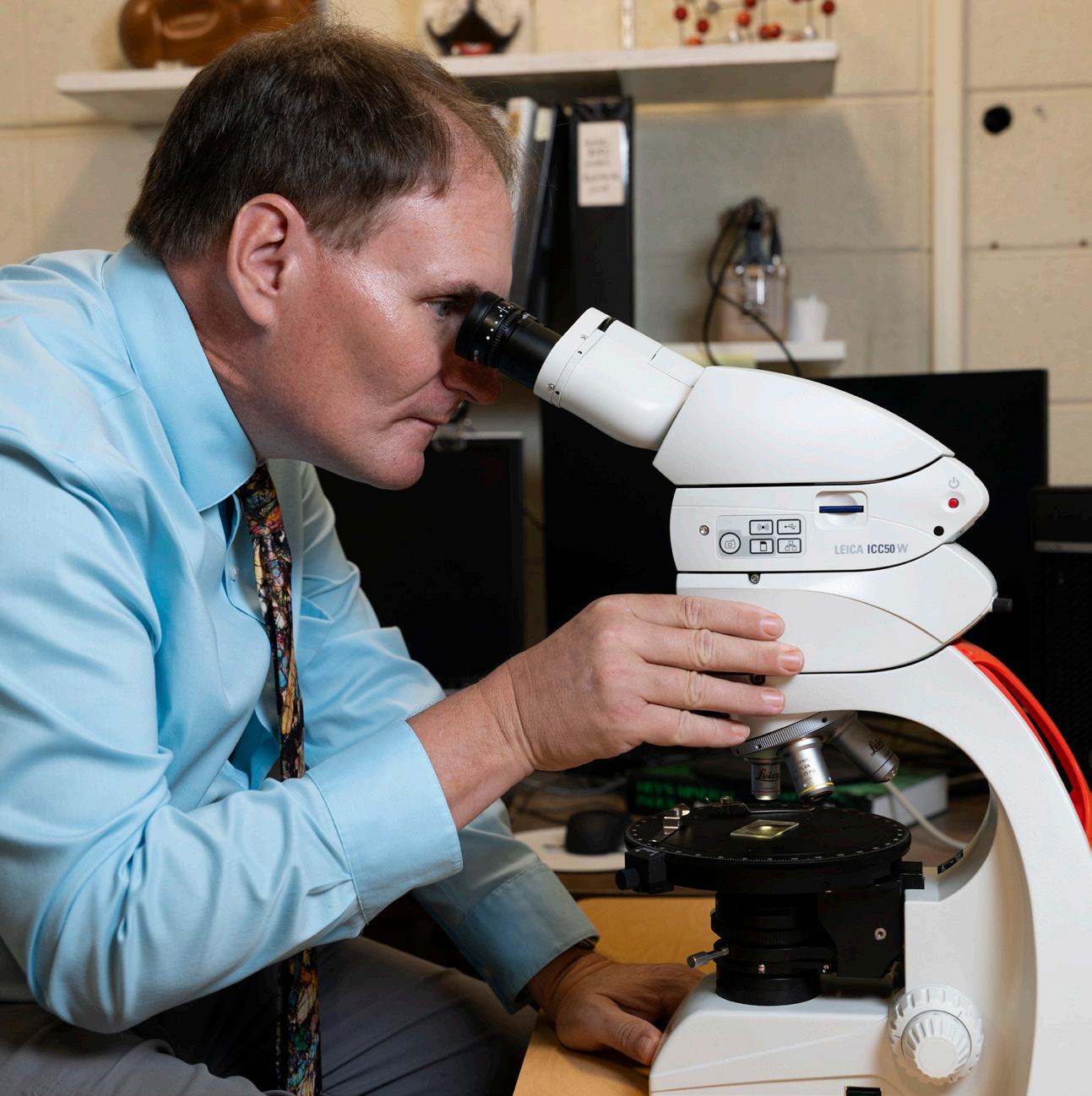
Using optical and electron microscopes to analyze the fragments, Harris says he believes the meteorite to be a low metal (L) ordinary chondrite, a specific combination of oxygen, drops of liquid, and minerals.
This classification puts the meteorite’s formation at 4.56 billion years ago. That makes it about 10 million years older than the Earth.

In addition to finalizing its lineage, UGA will submit findings,

ANDREWDAVISTUCKER
ANDREWDAVISTUCKER
along with the name McDonough Meteorite (meteorites get their namesake from the ZIP code they were found in), to the Nomenclature Committee of the Meteoritical Society. The official documentation will be published in the Meteoritical Bulletin
Just like the space rock itself, news of the discovery has exploded worldwide, appearing in The New York Times, on the BBC, and on CBS News, to name a few outlets.



The McDonough Meteorite is the 27th recovered in Georgia and the sixth witnessed fall.
In close-ups like this, you can see shiny, microscopic bits of metal. That’s what helped researchers determine the meteorite to be a low metal (L) ordinary chondrite.

Pƒrt of the fƒmily
UGA has been the premier destination for intergalactic rocks for many years thanks to its expert group of researchers.
In a box of previously named and identified meteorites, mysterious rocks, and unique formations, the McDonough Meteorite joins a long, extensive line of recovered cosmic wonders housed in the Department of Geology.
“UGA geologists also study moon rocks and meteorites from Mars, as well as satellite data that show what’s on other planets and asteroids,” says geology professor Paul A. Schroeder. “To make sense of those satellite images, it’s important to compare them with real samples we can hold in our hands. This kind of research doesn’t just answer big questions about the origins of Earth and life. It also helps prepare us for the future.”
The McDonough Meteorite will be stored at UGA for analysis and comparison to other samples. Additional pieces that fell in the area on June 26 will be displayed publicly at the Tellus Science Museum in Cartersville.
And as for the next crash landing? Keep one eye on the sky.
“I always joke that we need a stand selling steel umbrellas just in case,” Schroeder says. “Fortunately, these events are relatively uncommon, but we never know when something large is going to hit and create a catastrophic situation. So if we can guard against that, we want to.”

SOME SPƒCE TERMINOLOGY:

Asteroid: A small, rocky object that orbits the sun. Although asteroids orbit the sun like planets, they are much smaller.
Bolide: A fireball or meteor that is bright enough to be seen in the sky during the daytime.
Low metal (L) chondrite: The second most common group classification of meteorites.
Meteor: A space rock that enters the Earth’s atmosphere at high speed and burns up.
Meteorite: A meteor that survives its trip through the atmosphere and hits the ground.


Native to the Indian and Pacific oceans, this red lionfish is one one of more than 100 marine animals on display, offering a closer look at both native and invasive species along Georgia’s coast.
Where Coast Meets Classroom
From touch tanks to tidal creeks, the Marine Education Center and Aquarium immerses learners in the science of Georgia’s coast.
WRITTEN BY COLE SOSEBEE BSA ’19, MA ’25

At the end of a long road, framed by live oaks and the steady buzz of a maritime forest, sits one of the University of Georgia’s hidden treasures: the Marine Education Center and Aquarium on Skidaway Island. Just 30 minutes from Savannah, it offers visitors sweeping views of the marsh and a sense of wild seclusion.
Part of UGA Marine Extension and Georgia Sea Grant, the center has introduced generations to the wonders of the coast since opening to the public in 1971 as Georgia’s first saltwater aquarium. The center combines hands-on education, immersive fieldwork, and engaging exhibits to spark curiosity and stewardship.
Each year, thousands of K-12 students hike salt marshes, take research cruises aboard the R/V Sea Dawg, and peer into microscopes in on-site labs, while college students, teachers, and visiting scientists deepen impactful conservation and preservation work through internships, workshops, and research partnerships.
Science Up Close
Step inside the aquarium, and Georgia’s coast comes alive. Sixteen tanks feature more than 100 native species from seahorses to stingrays while touch tanks invite visitors to feel the shell of a horseshoe crab or observe the slow crawl of a hermit crab. Each display is designed with a purpose: to introduce the incredible diversity of coastal wildlife and connect it to larger themes of conservation and research.
For students of all ages, those encounters spark the kind of curiosity that textbooks can’t deliver. An afternoon exploring exhibits often dovetails with hands-on lessons in the lab or field, turning a look at a lionfish or oyster reef into a deeper conversation about invasive species, ecosystem health, and stewardship of Georgia’s coastline.
Anne Lindsay BS ’87 has spent nearly three decades creating an environment where discovery can happen at any age. She joined the aquarium in 1998 as a marine educator and now serves as associate director of education for Marine Extension and Georgia Sea Grant. She leads a team of educators whose programs are rooted in experiential learning while also aligning with Georgia Department of Education teaching standards, providing students with memorable experiences that connect directly to classroom learning.
“I have not met one person who didn’t remember some field trip they went on as a kid,” Lindsay says. “We’re trying to capture curiosity, excitement, and the willingness to explore the natural world and coastal areas because they’re so very important to our lives. Everybody is a fan of the ocean and the coast, but not everybody has had experiences that make those places personal to them. That’s what we try to do here.”
School groups can go behind the scenes to see how tanks are maintained, meet with marine educators for interpretive hikes on the nature trail, or take part in workshops on barrier islands that turn encounters with habitats and wildlife into broader lessons about ecology, climate, and conservation.
As part of the Coastal Guardians program, students explore the UGA Aquarium and coastal ecosystems while learning to become stewards of Georgia’s waterways.

“I have not met one person who didn’t remember some field trip they went on as a kid.”
ANNE LINDSAY, ASSOCIATE DIRECTOR OF EDUCATION, MARINE EXTENSION AND GEORGIA SEA GRANT

Science comes alive at Sea Camp, where students peer into microscopes, explore tidal habitat, and discover the diverse organisms that call coastal Georgia home.
Center: The UGA Aquarium’s research vessels give visitors and faculty the opportunity to interact directly with native marine species.
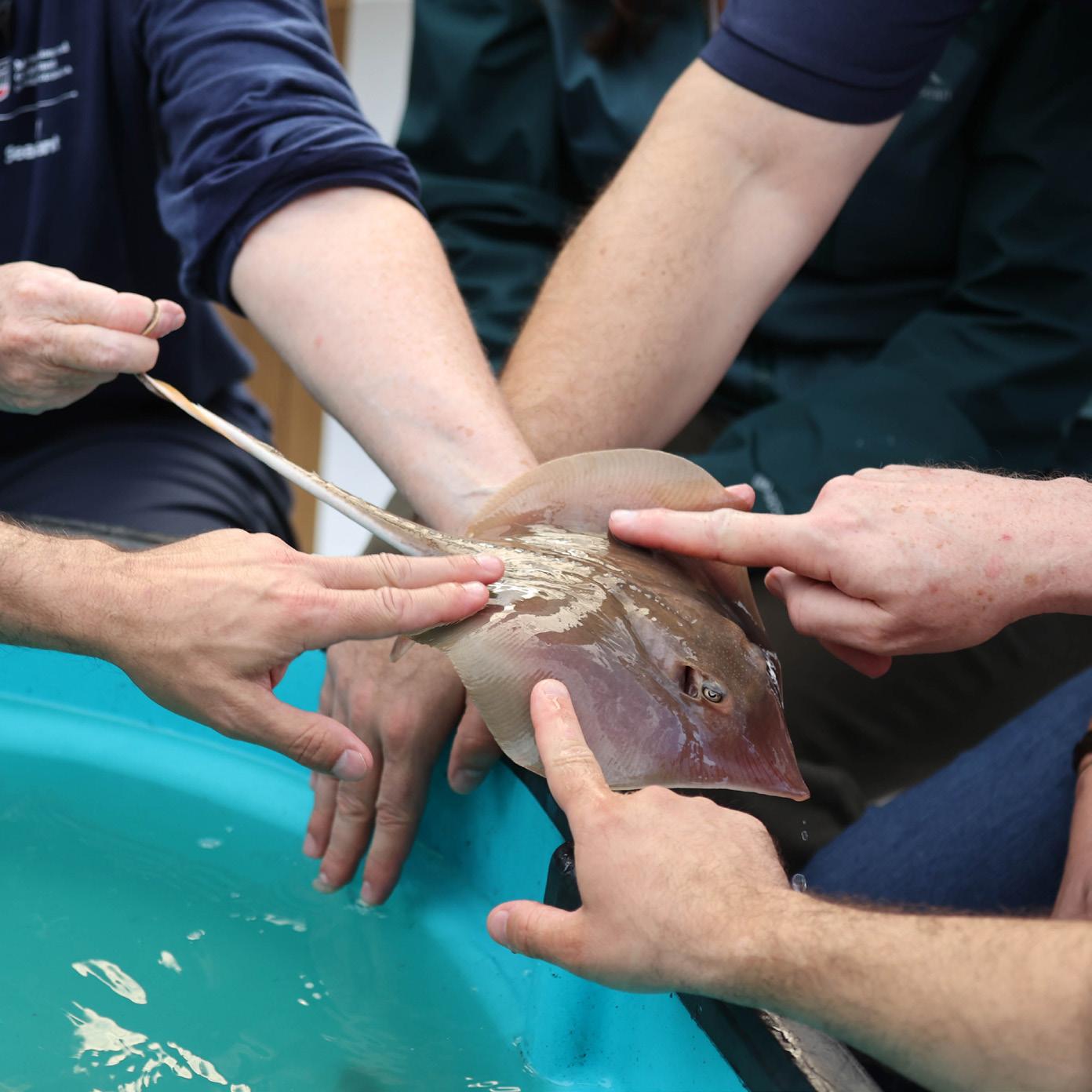
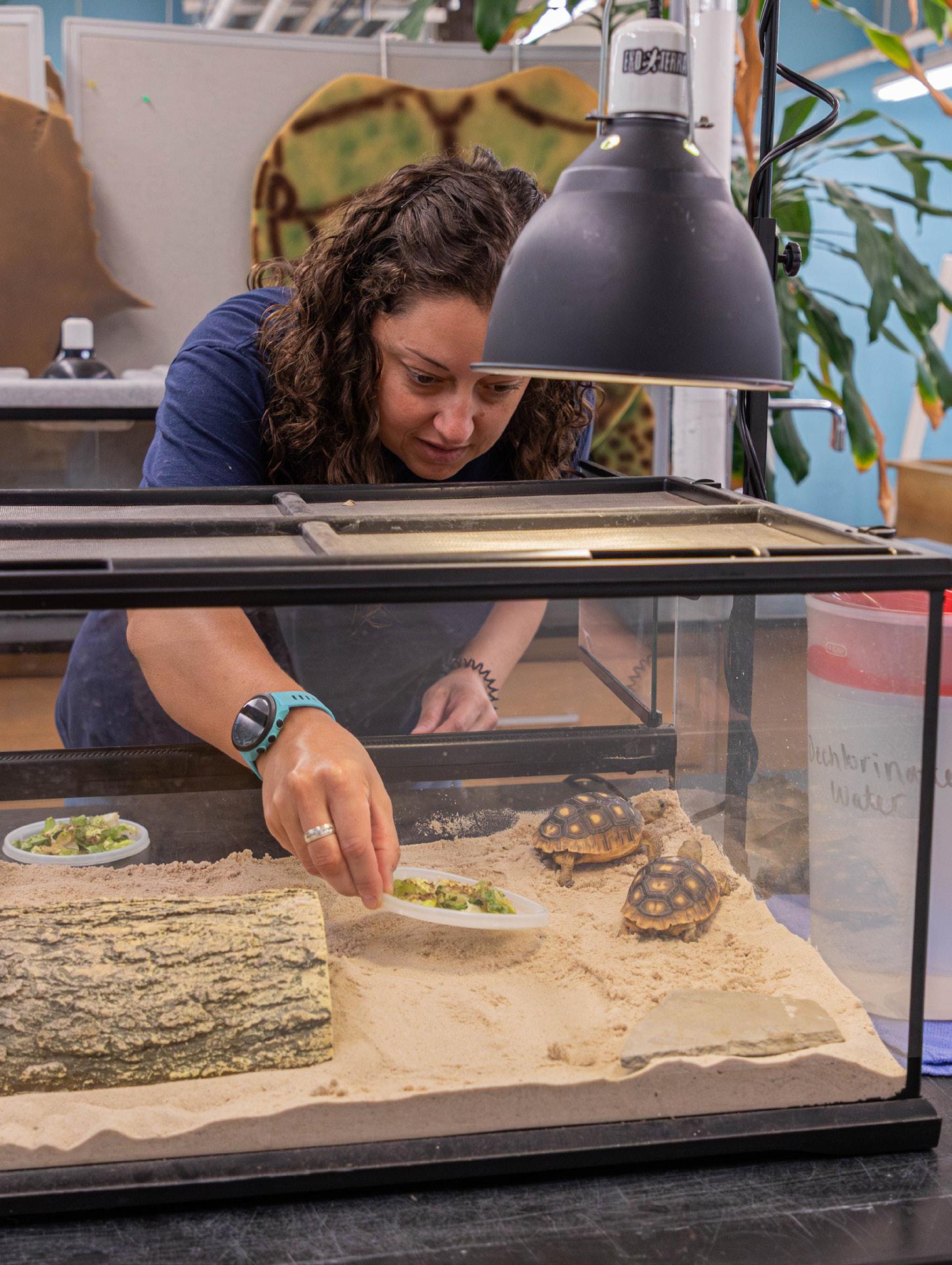
UGA Aquarium curator Lisa Kovalanchik feeds juvenile gopher tortoises in one of the teaching spaces at the facility.

Marine Science Mariners, a UGA Aquarium-sponsored camp for children ages 11 and 12, introduces campers to oceanography, navigation, chart plotting, seamanship, maritime history, and more! Visits to sites like the Wassaw National Wildlife Refuge, seen here, help kids understand Georgia’s coast from a mariner’s perspective.
SHANON WISE
SHANON WISE
BETHANNEDEKEIZER
TREY COOPER
Solving Salty Problems
The aquarium draws scientists from across Georgia who use its resources to study marine life and ecosystems. Graduate students, faculty, and partner researchers turn the surrounding waters and lab spaces into sites for discovery, often working alongside volunteers who help extend the reach of the scientists’ work.
For example, Mallory Mintz, a doctoral candidate in the Franklin College of Arts and Sciences’ Department of Marine Sciences, collaborates with the aquarium’s phytoplankton monitoring volunteers, part of a National Oceanic and Atmospheric Administration network, to track blooms of Akashiwo sanguinea, a red tide species
linked to harmful algae blooms. The volunteer program running at the aquarium spans more than 20 years and provides a rare long-term dataset while also giving the public a chance to contribute directly to coastal science.
Another focus at the aquarium is communicating science to the public, including research on living shorelines. These natural barriers, built with recycled oyster shells and native plants, protect shorelines from erosion. Unlike seawalls or bulkheads, living shorelines stabilize banks while creating oyster reefs, improving water quality, and providing critical habitat for coastal wildlife.
Bottom: UGA Aquarium curator Lisa Kovalanchik partners with a volunteer on behind-the-scenes work at the facility.
Inset Right: A common octopus is among the marine species featured in the UGA Aquarium’s exhibits.
UGA researchers are part of the Georgia Living Shoreline Workgroup, a coalition of scientists, managers, and conservationists testing these nature-based solutions across the coast. The aquarium’s newest exhibit, a 3D interactive diorama, brings living shorelines to life while sharing information about their benefits to coastal communities.


SHANON WISE
New Exhibits, More Opportunities
As the number of visitors to the aquarium continues to rise, staff are looking for ways to enhance exhibits and teaching spaces to showcase a broader variety of coastal wildlife to more people. Popular ambassador animals like gopher tortoises, diamondback terrapins, and non-venomous snakes are currently housed behind the scenes, limiting the aquarium’s ability to fully showcase the diversity of Georgia’s coastal and upland habitats.

“Having space for larger habitats that are more tailored to the wellbeing of our ambassador animals but that also evoke the natural behaviors of these animals gives people a glimpse into their lives,” says aquarium curator Lisa Kovalanchik MS ’22
“Sometimes, for some people, it takes learning a little bit more about an animal and its behaviors to really gain an appreciation for it or to become more comfortable with animals like snakes or alligators.”
New interactive exhibits will introduce visitors to the maritime forest ecosystem, with plans for a freshwater wetland exhibit, a multi-sensory 3D live oak tree, and a kid-friendly forest floor crawl.
New research-focused exhibits will provide opportunities for discovery while improved teaching spaces will allow educators to accommodate more school groups and visitors. With design concepts in place and fundraising underway, the aquarium aims to better reflect the richness of Georgia’s coast while inspiring the next generation of environmental stewards.

With its striking silver body and bold stripes, the spadefish (top, right) is a standout species in the UGA Aquarium’s collection.

“Sometimes, for some people, it takes learning a little bit more about an animal and its behaviors to really gain an appreciation for it or to become more comfortable with animals like snakes or alligators.”
LISA KOVALANCHIK, AQUARIUM CURATOR

A Virus Takes Flight
Avian influenza isn’t new. But the most recent outbreak’s rapid and prolific spread is setting off alarm bells.
WRITTEN BY LEIGH HATAWAY MA ’17
“Arguably, we are in the age of pandemics.”
It’s a bold statement. And perhaps hyperbolic.
But when someone like Justin Bahl says it, you should probably listen.
“We’ve challenged the environment to an extreme extent. We have increased the number of animals we’re producing domestically for food in an industrial way that requires us to maximize profits and speed. If a disease gets in there...”
The professor of infectious diseases and epidemiology at the University of Georgia trails off, leaving a palpable tension in the air. “We—as a species—are going to let our

guard down and sleepwalk into our next pandemic.”
Like thousands of his fellow scientists across the world, Bahl dropped everything when the COVID-19 pandemic hit, temporarily hitting pause on his own work to study the coronavirus, its transmission, and how it evolved from its animal host to infect humans.
Bahl doesn’t have a crystal ball. And like most researchers, you’d be hard-pressed to get him to predict which virus, bacteria, or fungi will cause the world to shut down next.
But there’s a reason he’s been working on avian influenza for two decades.


A Flu for the Birds
Avian influenza, or “bird flu” as it’s colloquially known, is a bit of a catch-all term.
There are multiple types of avian influenza, much like human seasonal flus. Different strains of bird flu are common in wild birds, and most of the time, they don’t even make the birds sick.
In 1997, things changed. A highly pathogenic avian influenza virus first identified in domesticated geese spread to humans working in the poultry industry in Hong Kong. Eighteen people were infected. Six died.
Less than a decade later, the same virus, known as H5N1, reemerged, this time causing widespread outbreaks in poultry farms across Asia.
Then it got into wild birds.
In partnership with the Georgia Department of Public Health, Justin Bahl co-leads the UGA Pathogen Genomics Center of Excellence, funded by the CDC. The goal of the UGA portion of the project is to translate new discoveries into usable data and interventions.

“There’s not much we can do about a viral infection that’s everywhere,” says Nicole Nemeth, an associate professor in the UGA College of Veterinary Medicine and head of the Southeastern Cooperative Wildlife Disease Study’s diagnostic service. Based in the UGA College of Veterinary Medicine, the cooperative provides wildlife disease expertise to state and federal fish and wildlife agencies, including the Georgia Department of Natural Resources.
As wild birds spread the virus around the globe, researchers began detecting new highly pathogenic avian influenza strains. H5N2. H5N6. H5N8.
In 2014, an outbreak in the U.S. resulted in the destruction of tens of millions of birds.
Avian flu seemed unstoppable. That is, until it kind of just went away on its own.
“Why did it fade away? We don’t really know,” Nemeth says.
That outbreak likely lacked the wild bird reservoir needed to sustain the virus, says Bahl, who has a joint appointment in the UGA College of Public Health and the UGA College of Veterinary Medicine. Bahl also serves as the co-lead of the CDC-funded Pathogen Genomics Center of Excellence.
Infected backyard poultry were culled, as were infected commercial flocks. While avian influenza never truly disappeared, reported cases decreased. Things quieted down.
Until 2020.
“The adaptability of this particular virus is phenomenal. It might actually have infected a greater diversity of hosts than pretty much any other virus that we know of.”
J USTIN BAHL, PROFESSOR OF INFECTIOUS DISEASES AND EPIDEMIOLOGY
Nicole Nemeth heads the Southeastern Cooperative Wildlife Disease Study (SCWDS) Diagnostic Service. SCWDS was the first to detect avian influenza in Georgia’s bald eagle population.
JASON THRASHER
JASON THRASHER
From One Species to the Next
While one virus raged in the human population, another slowly spread through waterfowl. First in Europe, then in North America.
Over the next few years, the new strain of H5N1 ripped through multiple wild bird species. Then it hit commercial poultry farms and backyard flocks.
In 2022, the U.S. Department of Agriculture reported something odd. H5N1 was infecting red foxes. And bobcats. And opossums. And mountain lions.
The list of infected mammals kept growing, with die-offs of every species from domestic cats to tigers, harbor seals to grizzly bears, and bottlenose dolphins to whales.
“The adaptability of this particular virus is phenomenal,” Bahl says. “It might actually have infected a greater diversity of hosts than pretty much any other virus that we know of.”
A scary prospect.
“This is something people should be concerned about,” says S. Mark Tompkins. “The virus evolved in about two years to infect over 100 mammalian species and kill them. That gives the virus the opportunity to change. That in and of itself is concerning.”
Tompkins heads UGA’s Center for Influenza Disease and Emergence Research, one of only six such institutions focusing on the history, transmission, and progression of influenza nationwide funded by the National Institute of Allergy and Infectious Diseases.
Tompkins was already in touch with the National Institutes of Health and the Food and Drug Administration when reports began circulating about avian influenza gaining a foothold in U.S. dairy cattle. His lab quickly became one of only five to test U.S. dairy supplies for avian influenza on behalf of the FDA.

IS MY MILK SAFE?
In short, yes. And so is the chicken you buy at the grocery store.
“Our food supply is safe,” says S. Mark Tompkins, who serves as a professor of virology and immunology in UGA’s College of Veterinary Medicine.
The virus has been detected in raw milk from infected cows, but pasteurization kills it, making it unlikely to infect people through consumption.
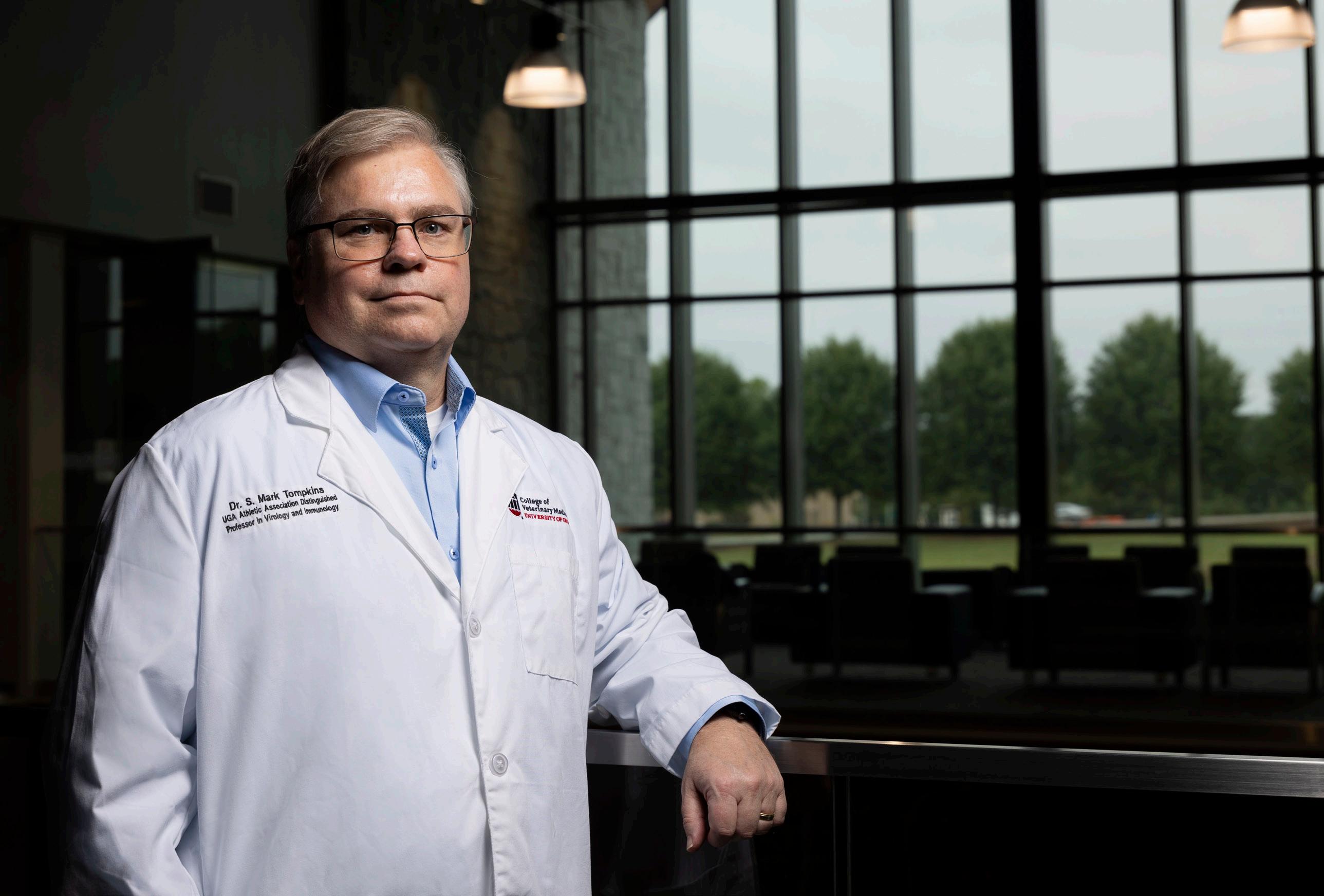
S. Mark Tompkins serves as the director of UGA’s Center for Influenza Disease and Emergence Research. The center is one of only six such institutions focusing on the history, transmission, and progression of influenza nationwide funded by the National Institute of Allergy and Infectious Diseases.
“This is something people should be concerned about. The virus evolved in about two years to infect over 100 mammalian species and kill them. That gives the virus the opportunity to change. That in and of itself is concerning.”
S. MARK TOMPKINS, DIRECTOR OF THE CENTER FOR VACCINES AND IMMUNOLOGY AND PRINCIPAL INVESTIGATOR OF THE CENTER FOR INFLUENZA DISEASE AND EMERGENCE RESEARCH

A Virus on the Move
Why dairy cattle? That’s the question plaguing researchers like Tompkins and Bahl.
Other species likely became infected through interactions with infected birds or their droppings. Something about the cows, though, appears to be different.
It could be because many of the country’s dairy farms are in the Midwest, directly under the migratory pathways of multiple wild bird species. Maybe their droppings land in the fields, and cows ingest them on grass?
Infected cows carry high viral loads in their udders. Perhaps the milking machines are passing the virus along.
Or are husbandry issues to blame? Cattle are sold and moved from farm to farm, carrying the risk of potentially spreading disease. Even something as simple as farmers forgetting to change out of their boots after tending to a flock of chickens could bring the virus along for the ride when heading to the cattle ranch.
It could be all of these or none.
“We don’t know how viruses are getting into poultry farms or cattle farms,” Bahl says.

GET YOURSELF SOME CHICKEN SHOES
Backyard chickens continue to be popular, but they’re not without risk. If you have chickens, poultry science professor Casey Ritz suggests designating a pair of sneakers or boots that you only wear in your coop. That will keep you from accidentally spreading any potential viruses or other pathogens around town.
Graduate research assistant Issabella Asamoah (left) and doctoral student Justin Shepard work with S. Mark Tompkins in the UGA Center for Vaccines and Immunology.
CHAMBERLAIN SMITH
Bird flu is a bit of a misnomer. While the virus may have started in birds, it quickly spread through multiple species, including but not limited to those depicted here.


Preventing the Next Pandemic
Despite the scientific advancements, the federal partnerships, and interdisciplinary scholarship happening on a global scale, avian influenza remains an enigma.
“Maybe we won’t be able to find out the answer as to why this happened or how to prevent it from happening again,” Tompkins says. “The complexity worries me.”
The uncertainty is unnerving for Bahl too.
“If we know exactly when and where it’s coming in, we should be able to prevent continuous spread,” he says. “We’ve done a pretty good job through depopulation of poultry. If it’s with wild birds, well, it’s much more difficult.
“But if we can understand the patterns of migration, the timing of spread between populations, incorporating host behavior and climate data, we can actually start
predicting when and where viruses might show up. Then we can mitigate a lot of the threats of highly pathogenic avian influenza.”
For now, the disease remains largely in the animal world, says Casey Ritz, a professor of poultry science in the UGA College of Agricultural and Environmental Sciences. Ritz is also a poultry specialist with UGA Cooperative Extension, a statewide resource that provides free, research-based information to Georgians through classes, programs, and general outreach.
Humans can catch it, but it’s rare. In the U.S., only 70 people have contracted avian influenza during the current outbreak. And most of those people worked directly with dairy cattle or poultry.
But three out of every four emerging diseases in people come from animals. And there’s nothing stopping avian influenza from joining that dangerous club.
Disease forecasting, though still in its infancy, may be the key to making Bahl’s dreams a reality.
With centers dedicated to the ecology of infectious diseases, to tropical and emerging global diseases, to the study of influenza and more, UGA is uniquely positioned to lead that charge.
‘In for the Long Haul’
As this story goes to print, reports of infected animals are dropping off, a hopeful sign that maybe this strain will peter out for a while like its predecessor. With fewer than 100 people infected, it appears unlikely that this is the next outbreak that will shut the world down.
But bird flu isn’t going away.
“We might be in for the long haul with this one,” Ritz says. “There’s no easy fix to this, and vigilance is going to be important.” GM

ON THE BULLDOG BEAT


The sale makes for a great way to pass the time between classes.
Sale offers something for everyone. Comics, movie, music, and arts fans unite as the academic year starts.

The Tate Student Center Poster
Cardboard-backed and crated, students peruse posters by the score.
CHAMBERLAIN SMITH
CHAMBERLAIN SMITH
DOROTHY KOZLOWSKI
WALL-TO-WALL WELCOME
Kicking off the academic year with the annual College Poster Sale
WRITTEN BY CAROLINE NEWBERN
With car trunks packed to the brim, University of Georgia students returned to campus the second week of August for the start of the new academic year. For nearly 40 years, the College Poster Sale has helped welcome them back.
For a full week, some 1,400 posters of all sizes line the walls and pile up on tables in the Tate Student Center Breezeway while students bounce in and out looking for new decorations.
“Working in an environment like this, it’s easy to stay energized,” says Whitney Cain, assistant director for facilities and operations in the Tate Center. “The poster sale is always a moment to see what is catching students’ attention and what they relate to. That’s refreshing because it changes from year to year.”
The sale is what Cain calls “a barometer on pop culture,” as students flip through
hundreds of posters ranging from music, art, movies, and everything in between. What they end up with is a personalized, one-stop-shop experience.
Large, wall-sized posters once dominated student tastes, but over the last couple of years, Cain has noticed a shift. Smaller 11x17 and 8x11 posters have become increasingly popular.
“Students create a collection of typically four to six posters. You could almost see students, in real time, create a gallery wall,” Cain says.
Each day, the sale runs from 9 a.m. to 6 p.m., but for Jeff Apostolou, it’s an early rise for setup at 6 a.m. and shutdown at midnight. A company road manager covering the southern territory, he has been coming to UGA for 35 years.
“Athens is a classic college town, not every school is like that,” Apostolou says. “Working here is a real pleasure for us.”
In part because of the company’s strong relationship with UGA over the years, Athens is the poster sale’s first stop on its national tour. That ensures UGA students get the best selection, and for Apostolou there is satisfaction in helping 800 to 1,000 of them celebrate the start of a new year.
Those students include Sofia Alfieri, a second year intended economics major, and Dhristi Patel, a second year majoring in pharmaceutical studies, who visited the poster sale in search of room decor.
While Alfieri found a large floral poster to put up in her living room after her first trip, she revisited the poster sale with Patel, who had something else in mind.
“My room is pretty bland, and I needed to spice it up a little,” Patel said, holding a poster of Canadian singer-songwriter The Weeknd. “I’m going to his concert. This is perfect.”

Some 1,400 posters of various sizes and prices are up for grabs during the weeklong sale.
CHAMBERLAIN SMITH

don't miss out!
FOUNDERS DAY
January 27
Celebrate 241 years of the University of Georgia as the birthplace of public higher education in America! Since UGA’s founding in 1785, the university has continued its commitment to its landand sea-grant mission, and to offering a world-class education that changes lives, transforms communities, and identifies solutions to pressing challenges. Learn more at uga.edu/about
DAWG DAY OF GIVING
March 26
Each spring, the Bulldog Nation rallies behind the university in a 24-hour day of giving to support programs, people, and priorities across UGA. These gifts remove barriers to higher education, solidify UGA’s position as an academic and athletic powerhouse, and unite a worldwide network of Bulldogs. Last year’s event set a record. Can the Bulldog faithful do it again? More at givingday.uga.edu
SENIOR SIGNATURE DEADLINE
March 31
Each year, thousands of graduating students make a difference at UGA by donating $30 to the university and designating a portion of that gift to a school, college, department, program, or scholarship that enhanced their UGA experience. March 31 is the deadline to give for any student who graduates in May, August, or December 2026. Learn more at alumni.uga.edu/seniorsignature
HARTMAN FUND DEADLINE
April 1
A contribution to the 2026 Hartman Fund allows donors to request renewable Georgia football season tickets; single home, away, and neutral site game tickets; and/or postseason tickets. Don’t miss the deadline. Details at thegeorgiabulldogclub.com/football
WELCOME, CLASS OF 2029!

Each August, incoming students gather in Sanford Stadium to form the Power G on Dooley Field. Freshman Welcome has quickly become one of students’ favorite traditions as they head into their first semester at UGA. See more photos at alumni.uga.edu/freshmanwelcome.
chapter spotlight
GREENVILLE CHAPTER
Chapter President: Nav Singh BS ’20 Number of Local Alumni: 5,491
The Greenville Chapter hosts events and programs throughout the year to celebrate the Bulldog spirit in upstate South Carolina. Last year, the chapter hosted a discussion with Travis Mountain, assistant professor of extension in financial planning, about estate planning and financial planning for college and retirement. This year, the chapter spearheaded a networking event to encourage graduates to support students through the UGA Mentor Program, and it hosted weekly football game-watching parties for alumni and friends.

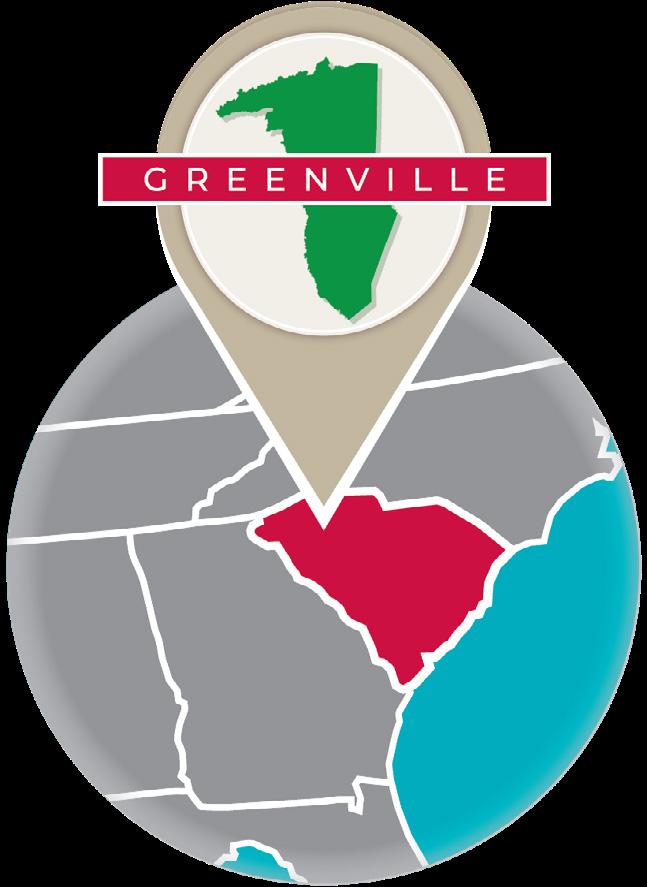

SPRING CAREER FAIR OPEN TO ALUMNI
Alumni are invited to attend the UGA Spring Career & Internship Fair at The Classic Center on Feb. 4. Learn more about this and other career programming for UGA graduates at career.uga.edu/alumni.

FOR THE BULLDOGS ON YOUR HOLIDAY SHOPPING LIST
If you’re holiday shopping for Bulldog friends or family, look no further than a UGA state decal (alumni.uga.edu/decals), official UGA Ring (alumni.uga.edu/ring), or a gift in their honor to support a campus fund of your choice (give.uga.edu/giftguide). ’Tis the season for red and black!
HELP PREPARE THE NEXT GENERATION OF PHYSICIANS AND HEALTH CARE PROFESSIONALS
As a top 20 public university with a thriving research enterprise and vast public service network, the University of Georgia is well positioned to produce highly trained physicians, help alleviate physician shortages, and improve the state’s ability to provide quality health care for its citizens. Private support is essential to attracting the brightest students from around the state and country to the School of Medicine by providing competitive financial aid opportunities. Learn how you can play a role in shaping the future of medicine in Georgia. More at give.uga.edu/medicine



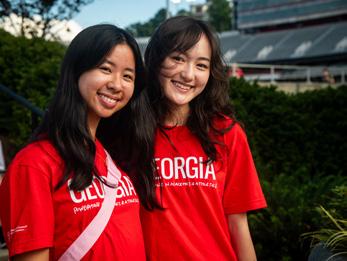

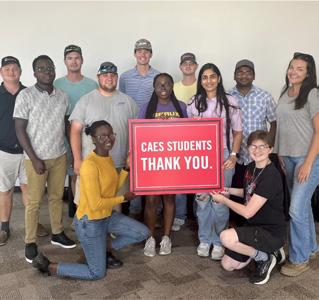
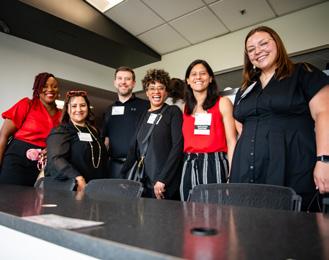

Check out what's going on for alumni and update your email or mailing address with UGA.



Located on UGA’s Health Sciences campus, the new medical education and research building will provide the UGA School of Medicine with capacity to expand from 60 students per class to 120 in the future.
class notes
ALUMNI PROFILE
The Spacecraftsman
Caleb Adams was one of those curious kids who was mesmerized by outer space—the mystery, the possibilities for new discoveries, and the futuristic gadgets that make space exploration possible. He once did an elementary school reading report on American astronomer Clyde Tombaugh and the discovery of Pluto.
“I always had space books and watched Carl Sagan’s [TV series] Cosmos,” he says. Today, Adams is helping shape the future of humankind’s ventures into the cosmos. And that future is, well, small.
Adams BS ’18, MS ’20 works in Silicon Valley at NASA’s Ames Research Center, where he helps lead efforts to develop automated spacecraft to manage traffic in Earth’s low orbit and perhaps one day explore deep space. The satellites he helps develop are “self-driving,” so to speak, and work in concert with each other; each is small enough to pack into a carry-on suitcase.
But the first satellite he helped build and saw launched into space was developed when he was a student at the University of Georgia.
Let’s Build
Despite his boyhood interests, Adams didn’t enroll at UGA expecting to work on space exploration. Instead, he came on a music scholarship to play trombone in the Redcoat Marching Band.
But Adams quickly gravitated toward grappling with technical challenges— the more challenging, the better. He built websites for local businesses before jumping into hackathons (collaborative engineering projects that last 24 to 48 hours) at UGA and other
Compiled by Caroline Newbern and Maura Rutledge
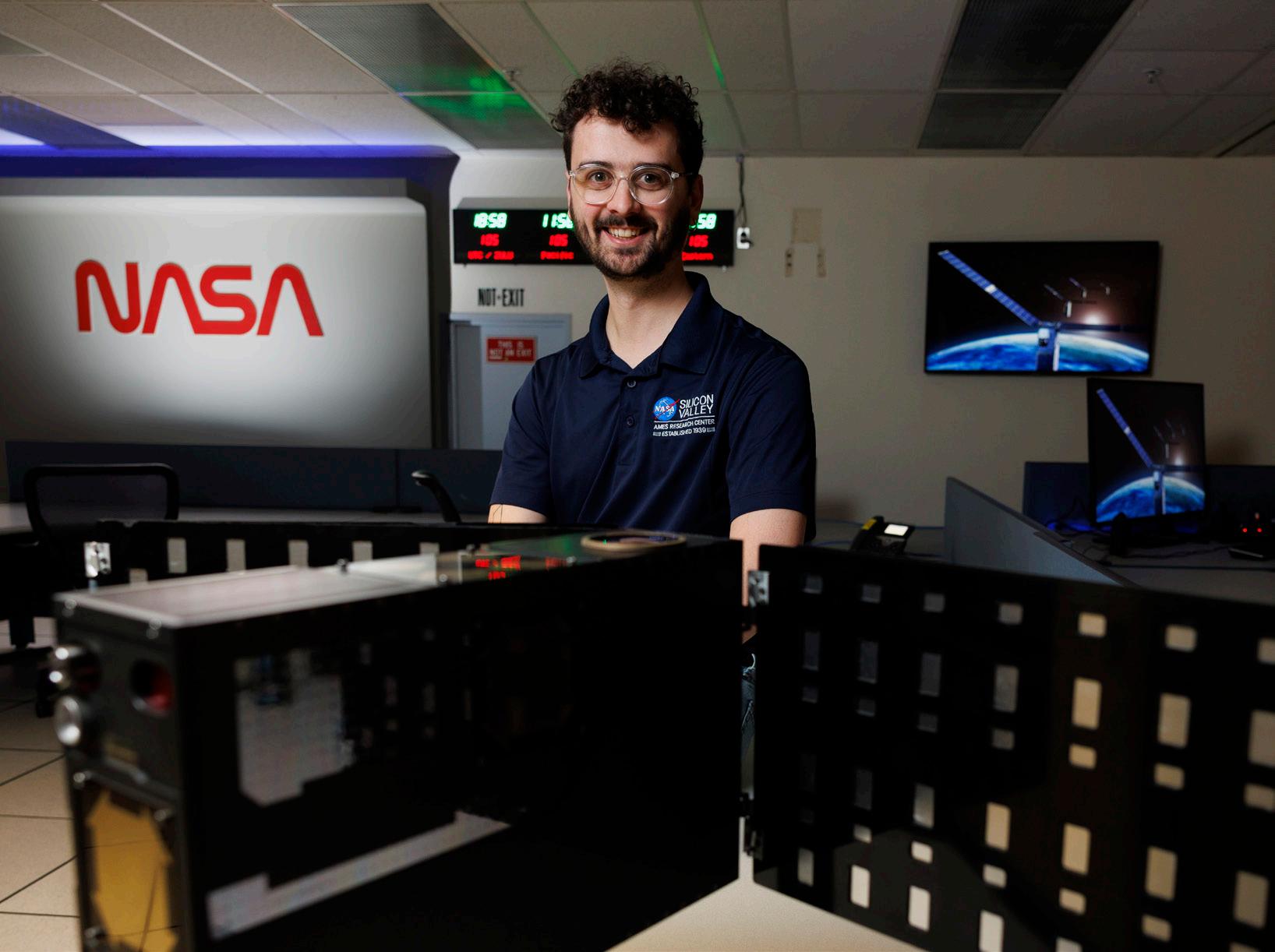
colleges. After developing a remotely operated telescope at one of these events, Adams and his buddies’ next challenge was to send something to space.
He plastered posters all over campus asking, “Do you want to make a spacecraft?”
His efforts got a huge response. With the help of fellow students and faculty, Adams co-founded the Small Satellite Research Laboratory, an interdisciplinary effort to send a spacecraft about the size of a 12pack of soda into space. The lab won competitive funding from NASA and the Air Force Research Lab, beating out other schools like MIT to secure Phase II funding to launch their satellite.
the satellites themselves with oversight from UGA faculty. The experience no doubt readied Adams for his career today.
“It’s like a systems engineering course for spacecraft. It takes you through the whole life cycle of building and operating these things.”
After earning his bachelor’s in computer science, Adams stayed on to work in the lab and earn a master’s in computer science, both degrees from the Franklin College of Arts and Sciences. After years of work from dozens of students and faculty, UGA’s first small satellite launched in 2020 just after Adams started his first job at NASA. He met with other UGA small satellite lab alumni at NASA’s Wallops Flight Facility in Virginia to see the launch.
The students built
ANDREW DAVIS TUCKER
NASA project manager Caleb Adams develops autonomous spacecraft that are about the size of an old school boom box (as seen in the foreground here).
1960-1964
Bob Powitz BSA ’64 serves as a forensic sanitarian in Connecticut and has been a credentialed/licensed sanitarian for the past 59 years. He authored more than 200 publications and delivered numerous lecture series on environmental health instrumentation and field practice.
1965-1969
Dean Kilpatrick AB ’65, MS ’67, PhD ’70 has worked full time as a distinguished university professor, director of the National Crime Victims Research and Treatment Center, and the National Mass Violence Center for 55 years.
1975-1979
Stephen T. Jackson BBA ’76 released the first two books of The Preston Chronicles. The sixth-generation Georgian is a historian, author, and a member of the Georgia Historical Society, The Atlanta History Center, and the Georgia Trust for Historic Preservation.

Space Traffic Control
Today, Adams is the project manager for distributed spacecraft autonomy and the deputy project manager for the Starling Mission.
The Starling Mission is testing the capabilities of a quartet of small autonomous satellites. The Starling satellites, each about the size of an oldschool boombox with two flat, foldable solar panel wings attached to power their systems, work together as a team called a “swarm.” And the swarm maneuvers through low orbit and collects data. One of the goals is to develop an autonomous air traffic control system in space to manage the thousands of satellites and spacecraft in Earth’s low orbit.
Written by Aaron Hale MA ’16
“You can imagine a situation like when you’re walking down the street, and you try to walk to the left and another person coming the other way goes to their right, and you keep trying to walk past them but can’t.”
That same technology could be used in the future as spacecraft swarms explore deep space.
This year, Adams and his team won a grant from NASA’s Early Career Initiative Program for their work on a low-light 3D mapping system that could illuminate hidden regions of our solar system.
Finding the Path
Looking back at his time in Athens, Adams is grateful for the range of opportunities he could explore at UGA.
“It feels like you can start on almost any path,” he says.
His Zell Miller Scholarship kept costs affordable. Other resources on campus, such as the Student Food Pantry, helped him stay focused on his interests. That work, and the collaboration that came with it, was a life-changing experience.
“It is to this day, one of the most motivated teams I’ve ever worked with. One of the most enthusiastic teams I’ve ever worked with. Incredibly collaborative. We all cared a lot about making something cool happen, and we felt good that there was progress toward that goal.”

Watch Caleb Adams speak about his work: T.UGA.EDU/CADAMS
Caleb Adams BS ’18, MS ’20
Caleb Adams observes a scale model of a rover inside the Lunar Lab at the NASA Ames Research Center.
ANDREW DAVIS TUCKER


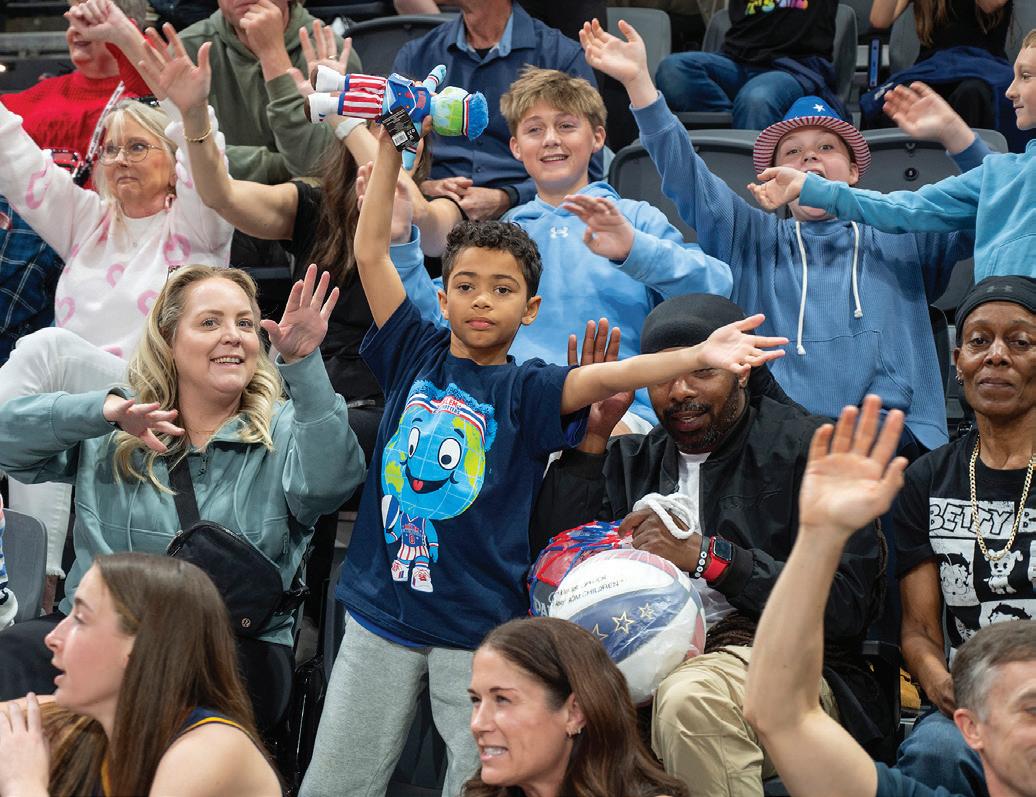
Whether you're into concerts, sporting events, or family shows, create your unforgettable moments at Akins Ford Arena in Downtown Athens, GA.


Every Moment Matters
As a UGA student, when Michael Lage entered the Leonard Leadership Scholars Program in the Terry College of Business, he was struck immediately by the passion of his fellow scholars. They wanted to make a difference in business and in the world.
The lessons Lage BBA ’05 learned in the program, a core offering of Terry’s Institute for Leadership Advancement, are ones he continues to utilize today.
“The No. 1 realization about great leadership is that it’s not about you. It’s about others,” says Lage, vice president for field operations with Chick-fil-A, Inc. “It’s about leading with a core set of values that creates tremendous value for the people around you.”
It’s that service-driven leadership perspective that made Lage an ideal match for his career.
Lage’s first job after graduating was with Chick-fil-A as a coordinator on its marketing team. He focused on restaurant and customer outreach. He loved the work, which he did for more than three years, but by Lage’s own admission, he also loved school.
“It was a dream come true,” he says about his admission to Harvard Business School, one of the only reasons he would have left his Chick-fil-A job.
While working toward his MBA, Lage interned at Google. After earning his degree in 2011, Lage stayed in the tech industry, working as a marketing strategist for Facebook (now Meta) on the West Coast.
While there, in contrast to the in-person interactions inherent in the restaurant industry, Lage learned how people engage with companies, organizations, and each other through their mobile devices. He’d soon be able to marry the two concepts.
When the opportunity arose to return to Chick-fil-A in Atlanta, Lage didn’t hesitate. He immediately put his tech experience to work and joined a team that included fellow UGA alumni David Salyers BBA ’81 and Kramer Johnson BBA ’08 to launch the Chick-fil-A app, one of the first mobilebased restaurant connections.
From that point, Lage’s journey has been on an upward trajectory with increased responsibility at every step. Lage was promoted to his current position last October. He helps lead the company’s field operations team, which keeps Lage on the road most weeks. He meets with Chick-fil-A operators across the country, and every conversation shines a light on a different angle of leadership. How can we continue to improve? How can we shine a light on the amazing experiences that take place every day? What can we learn from others?
And, since Chick-fil-A is one of the lead corporate sponsors of the ILA, Lage regularly returns to campus to speak to classes, visit with students, and reconnect with his professors and mentors.
Written by Eric Rangus MA ’94

“There is a spirit of curiosity, of hunger, of wanting to learn, of wanting to grow, of wanting to see what’s out there and what’s next,” Lage says about today’s UGA students, business and otherwise. “I’m continuously struck by the humility and eagerness and passion for learning.”
Every day is an opportunity for Lage to expand on his personal leadership growth.
“Every moment matters,” Lage says about the customer experience with Chick-fil-A, but, really, the sentiment could be applied pretty broadly.
“How do we empower our local owner-operators and position them to win that moment? How do they take care of customers and leave them driving away, going, ‘Man, I feel better about my day’? I feel the weight and responsibility for stewarding the trust and the promise so many of our customers have placed on Chick-fil-A over time. But, you know, I also realize that we get to do it together.”
Michael Lage BBA ’05
Michael Lage is vice president for field operations with Chick-fil-A, Inc. The role keeps him on the road much of the time, visiting restaurants and engaging in leadership conversations with owners and team members.
Bonnie & Lisa Real Estate



Allen Levi AB ’78, JD ’81 is the author of his debut novel, Theo of Golden, the story of a mysterious stranger who undertakes a campaign of generosity.
1980-1984
Mark Goldenberg BBA ’80 retired after two and a half years with RUCKUS Networks as an industry marketing manager and 27 years in IT marketing.
James R. Edwards Jr. AB ’80, MA ’83 released To Invent Is Divine: Creativity and Ownership, which reached the top 100 Amazon bestsellers in the Engineering Patents and Inventions category.
Maureen O’Sullivan Clayton ABJ ’80, MA ’84 is the co-chair of Grady College’s AdPR Executive Advisory Board and president at Insight Strategic Communications.
Pat Goslee BFA ’82 created a painting displayed at American University’s Katzen Arts Center during the survey exhibition “Women Artists of the DMV.” Nathan McClure BSFR ’83 retired after 42 years of service as a forester at F&W Forestry Services, an international company, and with the State of Georgia.

548-1311


Rising Up

Tori McElhaney’s first time playing football was also her last. While trying to run down the ball carrier in an all-girls flag football game in middle school, another player tripped her. McElhaney fell on her left hand, breaking her middle finger.
It’s a story that her football-loving family (including an uncle who was the first-ever Hairy Dawg) likes to bring up any time she’s analyzing plays made by Atlanta Falcons players.
“That was my villain origin story where I wanted to make football my career because I got it taken away from me before I ever even had the opportunity to truly play,” McElhaney
Written by Savannah Peat AB ’19
ABJ ’18 jokes. “My dad has always been a football coach, and we truly did bleed red and black as a family, so I always knew I wanted to go to the University of Georgia.”
As the senior reporter for the Falcons, the Grady College alumna is constantly writing, reporting, and conducting interviews with the team.
Whether it’s a coaching change, a player profile, or an injury update, if Falcons fans hear breaking news, it’s usually because McElhaney reported it first. McElhaney also reports live during games. During the off-season, she constantly works to promote the players and their stories.
She puts her expertise to use as co-host of the Falcons-centric show Rise Up Tonight on Fox 5 Atlanta. While McElhaney got her start as a print reporter, she’s such a natural broadcaster that it’s surprising that she used to avoid on-camera reporting.
McElhaney acquired the rapid-paced, think-on-your-feet skills to adapt and handle sports journalism (especially broadcast) at UGA. An entire semester of being the go-to live reporter for the student-run news station, Grady Newsource, didn’t hurt either.
“That was invaluable to me, looking back, because now I’m on camera every week,” she says. “At that time, I hated it because it didn’t feel like me. But life can have a different plan for you. Now, here I am at 29, a well-rounded journalist able to do a little bit of everything because that was what Grady allowed me to do as a student.”
McElhaney’s sports reporting also developed while she was still at UGA. From covering every Bulldog sport for The Red & Black to reporting Georgia football news for Dawg Nation starting in her junior year, she earned a spot writing with The Athletic, now owned by The New York Times, immediately after graduating.
More than three years in that job brought McElhaney to her role with the Falcons, where her reporting earned her the National Sports Media Association Georgia Sportswriter of the Year honor in 2024. McElhaney was the first woman from the state of Georgia to earn the accolade for the award that has been around since 1951.
She also won an Emmy for Best Sports Documentary this past summer.
But McElhaney doesn’t linger on these accomplishments too long. After all, it is football season.
“I feel like the Falcons went out on a limb to hire a true, capital-J Journalist to do internal reporting for the team,” she says. “I take that as a challenge to change the way that people look at in-house media. I love my team, and I love what I do.”
CHAMBERLAIN SMITH
Tori McElhaney’s student experience covering the Bulldogs helped prepare her for the season-long grind of game days as senior reporter with the Atlanta Falcons.
Tori McElhaney ABJ ’18
ALUMNI PROFILE
Kadi Tate BSEd ’83 is a retired educator and currently a Realtor for Keller Williams Realty Greater Athens.
Lori Oliver ABJ ’84 and Jill MacRae BSFCS ’91 are the co-founders of The Inactive Company, a performance sleep brand.
1985-1989
John Hardman II BBA ’86 is a retired peer specialist with Northwest Behavioral Services in Jacksonville, FL. He is also a retired bookseller with Barnes and Noble Booksellers in Saint Augustine and a retired forest ranger for the U.S. Forest Service in Pinedale, WY.
1990-1994
Kat Shreve BSEd ’90 is the executive director of Aurora Day Camp in the Greater Atlanta area. Shreve also leads the American Camp Association National Awards Committee. Carri Lauder BSFC ’92 is working at CMI, a site work contractor based in south Georgia.
Melodee Loeffler BSPH ’92 is a pharmacist for Memorial Hospital and Manor in Bainbridge, where she has worked since 1996.
Leigh Burns BSEd ’93 is the director of the Fox Theatre in Atlanta. She was selected as a 2025 finalist for Atlanta Magazine’s “Women Making a Mark” award.
Troy Aubrey ABJ ’94 is the president of Aubrey Entertainment, an Athens-based booking and concert promotions business. He is involved in the annual AthFest Music & Arts Festival.
Denise Stone Ciccarelli AB ’94 is the assistant vice president of corporate partnerships for Clemson University.
1995-1999
Eddie Flynt BBA ’95 is a State Farm agent in Chamblee and Peachtree Corners.
Jennifer Garland BBA ’95, MBA ’98, JD ’08 owns several businesses in Watkinsville, focusing on business strategy, tax minimization, conservation, oil and gas, and law practice, serving clients across the U.S.
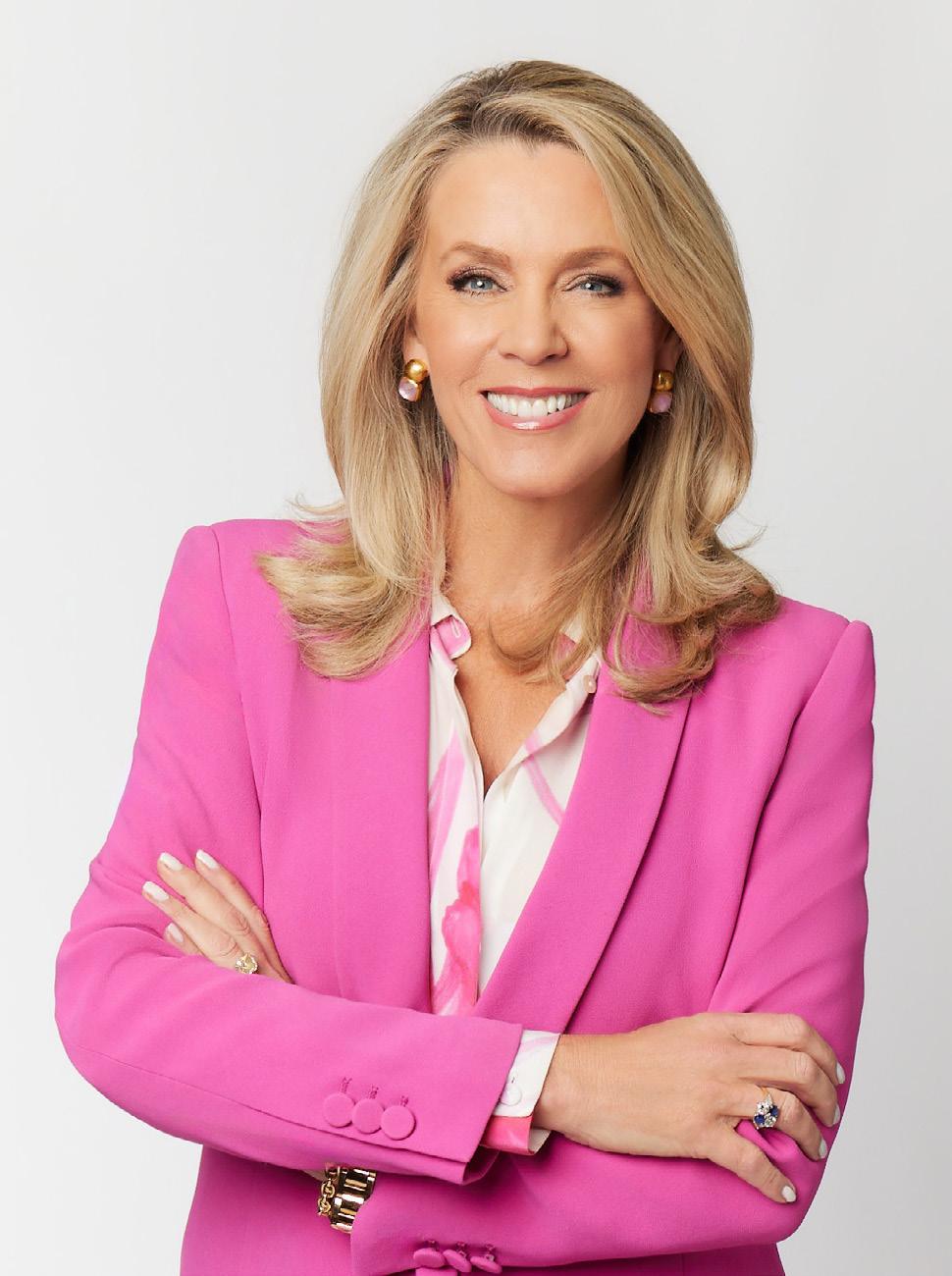
DLIFETIME ACHIEVEMENT
Artis Stevens AB ’97 serves as president and CEO of Big Brothers Big Sisters of America. He was named to the inaugural TIME100 Philanthropy 2025 list.
Kristi Franklin McBride BSFCS ’98 has worked in higher education for more than 25 years and, 18 years ago, was named the first admissions counselor at Georgia Gwinnett College. The college named the Kristi L. McBride Training Room in her honor.
Ben Holst ABJ ’99 and Rachel Kopp ABJ ’17 work for Volume.com, the livestreaming platform that produces the AthFest Music & Arts live broadcast.
2000-2004
Scott Butler AB ’00 was appointed city manager of Mesa, AZ.
Jennifer Nilsson BBA ’00 and Merissa Davis BFA ’03 are celebrating the 10-year anniversary of their creative marketing agency, Clementine Creative.
eborah Norville ABJ ’79 began her journalism career at Atlanta’s WAGA-TV while still a student in the Grady College of Journalism and Mass Communication. Now, 45 years into a career that’s still going strong, Norville received the prestigious Lifetime Achievement Honor at the 52nd Annual Daytime Emmy Awards.
Norville is the longest-serving female anchor in American television history, including three decades as anchor of Inside Edition, which became the nation’s No. 1 daily news magazine under her leadership.
Norville joined Inside Edition in 1995 after a distinguished run at CBS News as an anchor and correspondent. She also served as co-host of NBC’s Today, anchor of NBC News at Sunrise, and host of Deborah Norville Tonight on MSNBC. She returned to television in September as host of the syndicated game show The Perfect Line. The show employed six Grady students and alumni as production assistants.
“When I first walked into a newsroom as a college student, I couldn’t have imagined a journey that would span more than four decades, take me around the globe, and introduce me to so many remarkable people,” Norville said, prior to the Oct. 17 ceremony. “The Lifetime Achievement Honor is an extraordinary capstone.”
MY GEORGIA COMMITMENT
Getting to know UGA’s most committed Bulldogs
Howard and Becky Young met at UGA and are now among the university’s most loyal supporters.

Howard BBA ’82 and Becky Young AB ’82, began dating during their sophomore years at UGA and eventually married. More than four decades later, their connection to UGA remains as strong as ever, spanning three generations of Bulldogs. Together, they have donated to support athletics, scholarships, professorships, and the new UGA School of Medicine. Howard, chair of the UGA Foundation Board of Trustees, and Becky, a founding donor to Georgia Women Give and member of the Dean’s Advisory Council for the College of Environment and Design, extend a Bulldog legacy of giving back.
Q: Where does your UGA story begin?
Howard: My parents met at UGA, so I grew up knowing I would be a Bulldog. I studied in Terry College and, along the way, met Becky.
Becky: I came to Athens to study in Franklin College, never expecting to meet my future husband here. Together, we raised three children who all went to UGA, and now we have five granddaughters and one grandson, each with plenty of red and black in their closets.
Join committed alumni like the Youngs in supporting UGA.
Q: What is a treasured UGA memory?
H: Our first date for the Georgia vs. Kentucky game in 1979. I still have the ticket stub.
B: The Lindsay Scott touchdown against Florida in 1980. That moment united the entire campus, and we rode that excitement all the way to the national championship.
Q: What keeps you connected to UGA?
H: Giving back to the place that gave us so much. Every trip to Athens feels like coming home, and we make any excuse to come back.
B: Our children, our lifelong friends, and our social life, which mostly revolves around UGA football games!
Q: Your giving to UGA spans across campus and disciplines. What prompted you both to support UGA in this way?
B: We were both raised to give back, so we want to do all we can to pay it forward. Plus, there’s just so much happening in every corner of campus, and it’s exciting to still be a part of it.
Q: Do you think of UGA differently now compared to when you first stepped on campus?
H: I am more proud of my diploma than ever. UGA’s reputation as an academic and athletic powerhouse is well-earned. We love seeing how the university evolves and improves over time, like the Double Dawgs program, for instance. There are always new opportunities waiting!
Q: Becky, what inspired you to join Georgia Women Give?
B: Georgia Women Give engages a philanthropic community of successful alumni and friends who want to pay that forward to current and future students. It really is an energizing way to connect with others who care about UGA and pool our resources to help the next generation.
Q: You’ve given to help build the new UGA School of Medicine. What does it mean for you to be part of that?
H: It is a big moment in UGA’s history and addresses a critical need for Georgia. Sadly, there is a shortage of physicians in the state, but this school will play a major role in addressing it. It will also open up research opportunities and expand what the university can do for the state.
Q: What would you say to the UGA community about involvement and giving?
H: Think of giving to UGA as an investment. Every class that graduates is prepared to take on the challenges of today’s world. The UGA Foundation takes its role as steward of donor resources very seriously, ensuring every dollar is managed with utmost care, spent efficiently, and directed exactly where donors intend to make the greatest impact.
B: You get more back than you give. Your support can change a student’s life, and that impact carries forward to future generations.
BRIAN POWERS
The Man Behind the Mascot

Hairy Dawg was born in a basement, and he was delivered in a hurry.
Three weeks before Georgia’s showdown against Notre Dame in the 1981 Sugar Bowl, Tom Sapp BFA ’69 showed coach Vince Dooley some sketches for an idea he had.
They depicted a broad-shouldered, tough-looking figure with a bulldog’s head, oversized paws, and a football player’s body. Dooley liked the idea and said Sapp could build the costume—but only if he could have it ready in time for the bowl game.
With the help of his friend Mac Talmadge, Sapp turned his basement into a crash-course workshop, sewing and gluing late into the night until his creation was finally complete.
Hairy trotted onto the field in New Orleans, where Georgia went on to win its second national championship, and
a legend was born. Not bad for a mascot with a three-week gestation.
An Artist in the Making
Sapp’s journey began in Macon, though his childhood also included stints in Savannah. By the time he arrived in Athens in the late 1960s as a graphic design major, he was already passionate about art and illustration. He credits his professors and fellow students with fostering and helping him hone those skills.
“Many of my best friends to this day came out of that group,” he says. “Our professors pushed us hard, and those lessons stuck with me throughout my career.”
Fresh out of UGA in 1969, Sapp joined McCann Erickson’s Atlanta office as an art director, working on major corporate accounts. His ability to both design and
illustrate gave him an edge. Over the years, Sapp moved through other creative director roles at agencies large and small.
“Most art directors couldn’t really draw,” he says with a laugh. “But I could, and that opened a lot of doors.”
The opportunity to design and build Hairy Dawg came suddenly, but some might argue that the creation of a new costumed mascot between the hedges was overdue. In the late 1970s, UGA’s official costumed mascot was “Fluffy,” a portly, gray bulldog that didn’t quite cut the intimidating figure to match the ferocity of the Bulldogs on the gridiron.
The University of Florida, meanwhile, had unveiled a new gator mascot, prompting one of Sapp’s friends to suggest that Georgia needed a mascot that could stand toe-to-toe with “that damn gator.”
Sapp drew the sketches, got approval, and built the costume. Hairy was well
ANDREW DAVIS TUCKER
Tom Sapp, the creator of Hairy Dawg, has crafted mascots for schools and companies across the country, turning his artistic talent into an incredible career.
received in New Orleans, and Sapp got a special invitation to see Hairy make his home-field debut at the next season’s opener. But when Hairy appeared, Sapp was underwhelmed.
During a commercial break, though, he noticed children running down the steps of Sanford Stadium, and he craned his neck to see what was causing the commotion. It was Hairy. The children were flocking to him to give him a high five, to have their picture taken, or to ask for his autograph.
“The hair stood up on my arms,” Sapp says. “That was the moment I realized this was bigger than I imagined.”
From
the Basement
to the Big Leagues
Hairy Dawg’s success brought Sapp national attention. Michigan State called next, asking for a Spartan warrior now known as Sparty. The Kansas City Royals followed with a request for Sluggerrr the Lion. Soon, the requests poured in. By 1989, Sapp had launched Real Characters, Inc., a design studio specializing in mascots and brand characters.
Since then, Sapp has designed hundreds of mascots ranging from Rocky the Mountain Lion of the Denver Nuggets, to Harry the Hawk of the Atlanta Hawks, to Fumbles the College Football Hall of Fame’s goalpost-eared creature of indeterminate origin. His designs extend beyond sports, including the production of more than 6,000 Chick-fil-A cow costumes.
“What I brought from advertising was the discipline to listen,” Sapp says. “It’s never about me. It’s about the client … who they are, what history they want to honor, and how their fans connect. That’s how you create something that lasts.”
But even the most successful mascots need updates.
Hairy Dawg has undergone subtle refinements over the years.
Early versions had limited mobility. Later iterations included a helmetmounted head for more flexibility. Details like Hairy’s eyes, lips, and collar have been
Written by James Hataway MA ’10

tweaked to keep the design fresh while preserving his essence.
Behind each creation is a team with diverse skills. At International Mascot Corporation—where Sapp serves as creative director and manager of manufacturing—sculptors, seamstresses, and painters bring characters to life.

“When you see your character embraced, when kids run to it for pictures or fans chant its name, that’s the payoff,” he says.
“It means you captured something real.”
“I don’t build costumes myself anymore, but I supervise every step,” he says. “I’ll tell a sculptor, ‘This isn’t quite right. Adjust the chin. Reshape the eyes.’
“It goes back to what my painting teacher told me at Georgia: I’m not going to teach you to paint. I am going to teach you to see. That has served me more than any other tip I got in the business.”
For Sapp, the real reward is the connection mascots create.
Even now, decades after that first Sugar Bowl debut, Sapp remains deeply tied to Hairy Dawg.
“It all goes back to Georgia,” he says.
“That’s where I learned the discipline, the creativity, and the joy of building something that connects with people.”

Tom Sapp BFA ’69
ANDREWDAVISTUCKER
Hunker Down with more Hairy Dawg photos:
Tom Sapp (left) and Mac Talmadge (right) unveil Hairy Dawg to former UGA head coach Vince Dooley.
Inset: Early drawings by Tom Sapp that served as the foundation for Hairy Dawg’s design.

Homes in AL, FL, GA, NM, OK & TN
Chris Coley CEO/Founder
Michelle Schreiner BS ’00, MS ’02, PhD ’05 leads a UX Research team at a Fortune 50 company and has published her debut children’s book, Charlie and the Funky Monkeys Challenge, inspired by a UGA research study she helped lead that debunked gender myths in spatial reasoning.
Jenny Bryant BBA ’01 is the director of carrier relations at Sterling Seacrest Pritchard insurance brokers.
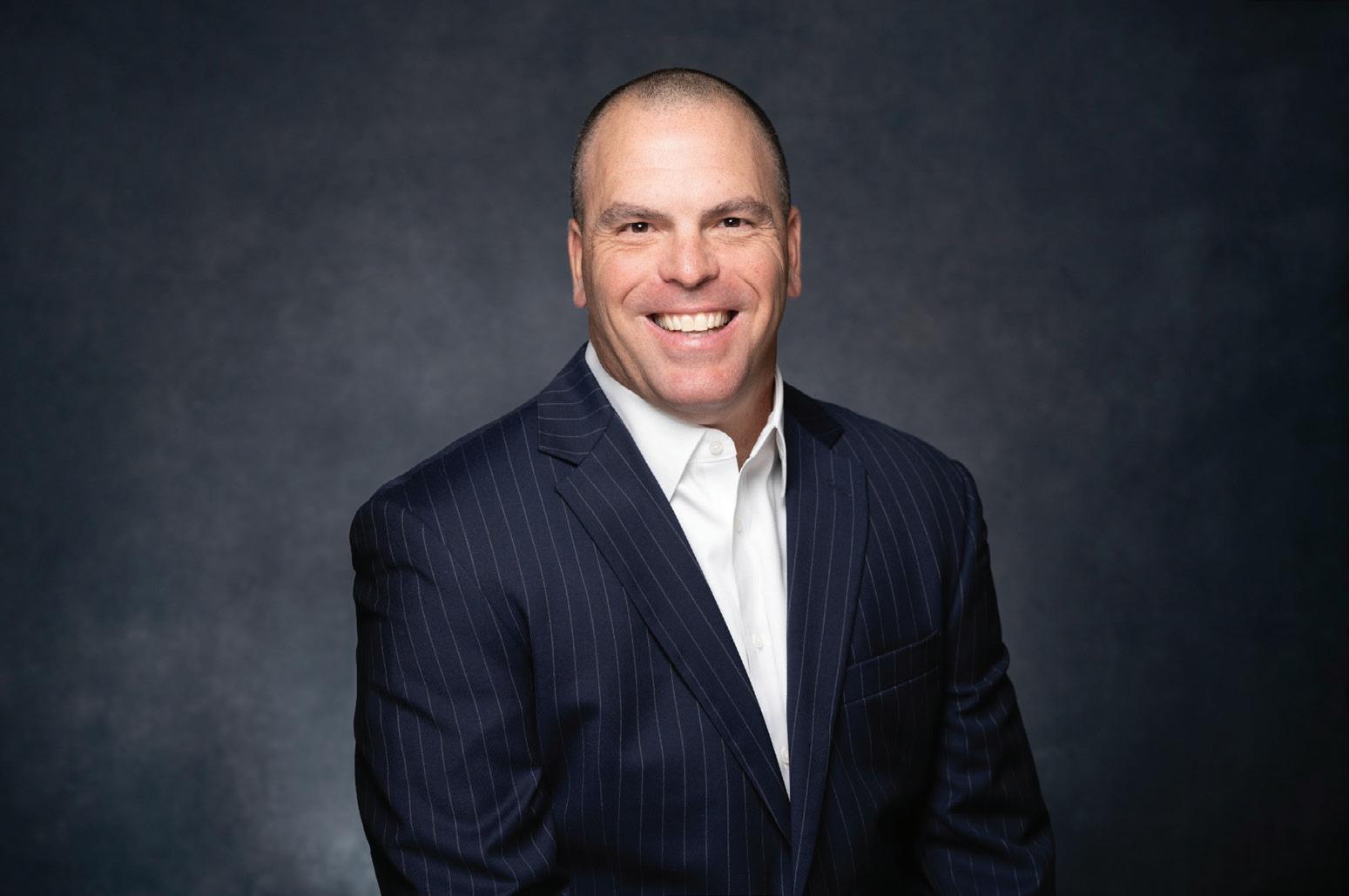


Melody L. Copenny ABJ ’01 is a senior digital editorial strategist for the U.S. digital strategies division of Cru, a global nonprofit.
Rhett Parker AB ’01 completed a Master of Public Safety Administration at Columbus State University-Law Enforcement Command College and was promoted to sergeant first class/ post commander of the Georgia State Patrol post in Gainesville. He has served GSP for 24 years.
Brad Brookshire BBA ’03 is CEO of Great Oaks Bank, Richmond Hill, and was elected to serve a three-year term on the board of directors of the Georgia Bankers Association.
Darrell Kinsey BA’03 serves a marketing assistant at the University of Iowa Press and is the author of the novel Natch. Hunter Blake BSA ’04 owns the concert and event production company Hunter Blake Productions in Nolensville, TN.
Jonathan Dalrymple AB ’04 is the CEO of Chugach Alaska Corporation, based in Anchorage.
2005-2009
Taylor Dibbert AB ’05 has published several books of poetry including Rescue Dog, his fourth full-length poetry collection.
Abinue Fortingo AB ’05, MPH ’11 serves as an employee well-being and population health management strategist.
Emily Kathryne BSES ’05 was promoted to associate director of sustainability reporting at JM Huber Corp., a chemical manufacturer.
Taylor Murphy BSFCS ’09 serves as the national director of U.S. State, Local, and Education Solutions at Gigamon, where he leads initiatives to enhance cybersecurity and network observability across public sector organizations. He also completed the Terry College of Business Certificate in Business Leadership.
2010-2014
Dr. Cameron Banks BSHP ’10 was named president of the American Chiropractic Association’s Council on Chiropractic Orthopedics. He is employed by AICA Orthopedics in Snellville.
Dustin Graham BSEd ’10 works as a playground designer and helped write language for Georgia House Bill 371.
Kristen Turner BS ’10 is a registered behavioral therapist pursuing a master’s degree in applied behavioral sciences at Capella University.
Ashley Weed AB ’10 joined the UGA Research Institute’s project management team.
Josh Delaney ABJ ’11, AB ’11 is the legislative director for Sen. Rev. Raphael Warnock.
Chelsea Howell BSA ’11 is a certified surgical physician assistant working in liver and kidney transplant surgery in Atlanta.
Cortney Newmans BSFCS ’11 is the CEO of Asteris Lending, a new institutionally backed private lending firm headquartered in Atlanta.
Taylor Hilley ABJ ’14 got married in March and is now working at Porsche Cars North America as the brand manager for Porsche Classic.
2015-2020
Paul Chitwood BBA ’15, BBA ’15, BBA ’15 was promoted to vice president, southeast underwriting manager for Chubb Global Casualty.
Matt Gobel AB ’15, AB ’15, JD ’18 has joined HunterMaclean’s corporate practice group. Single Family, Land, Hotels, and Vacation
David Pittman ABJ ’06, BS ’06 recently graduated with his Master of Public Health from the Johns Hopkins Bloomberg School of Public Health.
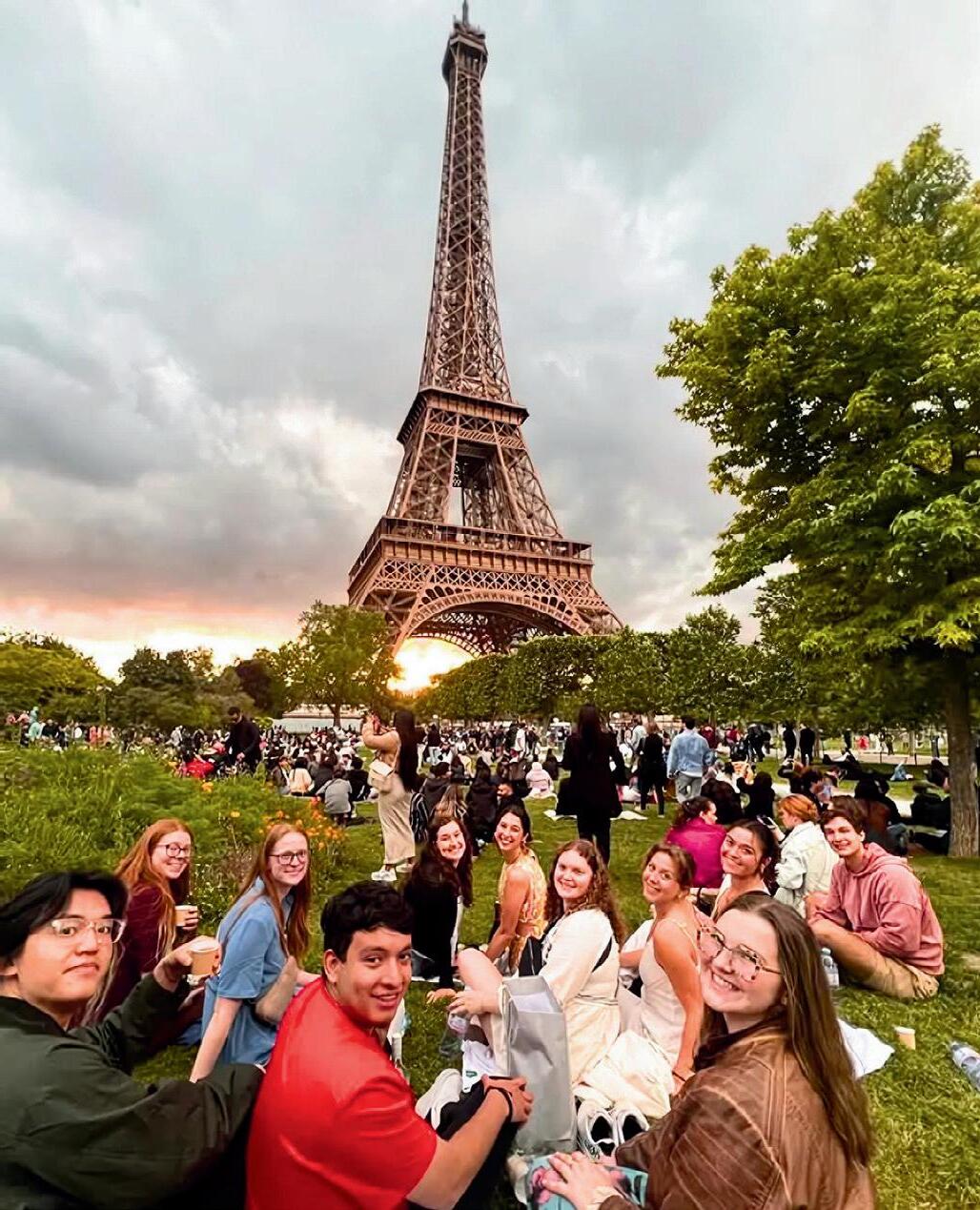





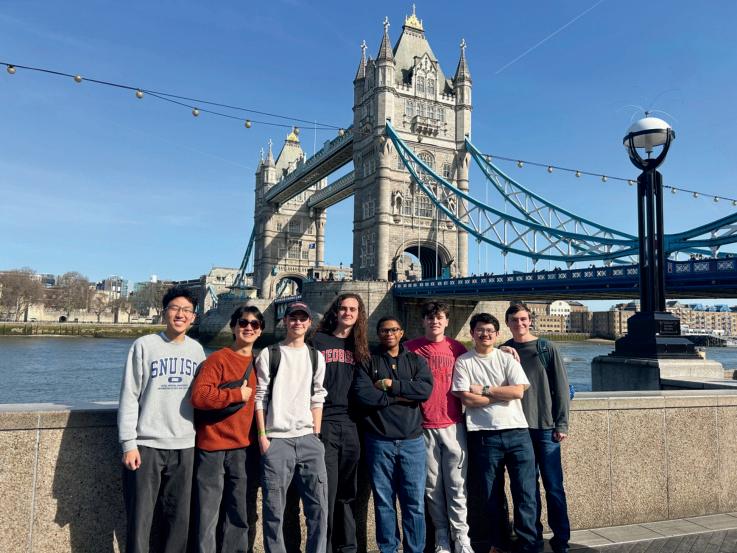

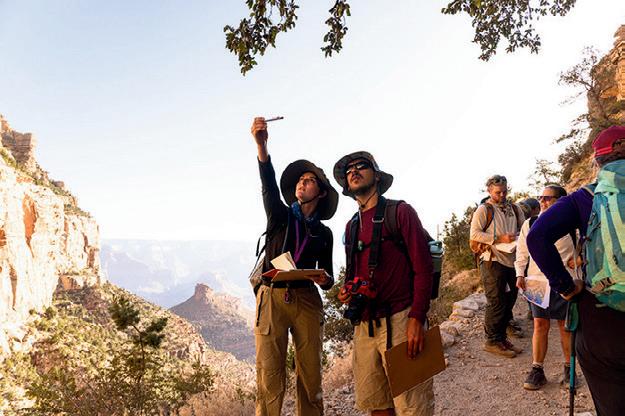

THE WORLD IS THE BEST CLASSROOM
Whether it’s two weeks in Silicon Valley or New York City, a field research study in the U.S. National Parks or a cultural immersion in Europe, study away programs open doors to transformative learning experiences across the country and globe. These journeys challenge students to think critically, build lifelong skills, and connect classroom learning to real-world contexts. For many, it’s a defining chapter in their college experience. But for some, financial barriers make these life-changing opportunities impossible. Your gift to experiential learning/study away scholarships doesn’t just fund travel-it opens minds, expands horizons, and shapes futures.
"Traveling without the burden of money let me focus on what truly mattered. Knowing someone believed in me means more than anything money could buy.”
- Izabella Z., Psychology and Communication Studies Double Major
SUPPORT STUDY AWAY TODAY
Give a student the chance to discover new places, new ideas, and new possibilities.

Joe Vaughn BSFR ’16 was selected for UGA’s 40 Under 40 class of 2025, appointed to the Black Alumni Leadership Council, and began a new role with F&W Forestry, advising landowners and investors on sustainable timber management.
Kunal Tanna ABJ ’16 serves as the assistant to the general manager of the Kansas City Chiefs and was recently inducted into the Georgia chapter of the National Wrestling Hall of Fame.
Yujin Ahn BSFCS ’17 is conducting research with the Department of Plastic and Reconstructive Surgery in the Dongguk University College of Medicine and is a research professor at Seoul National University in South Korea.
Janet Kirby BSFCS ’17 serves as a special education teacher in Gwinnett County Schools in addition to volunteering with the nonprofit, Eagle’s Nest, in Roswell.
Natalia Sanchez AB’17 serves as CEO of STR Fleet Services and South Commercial Cleaning , two Georgiabased companies providing fleet maintenance and professional cleaning solutions across the state. She serves as director of international relations at ATC
Logistics, working to strengthen trade and logistics connections between the U.S. and Latin America. In 2024, she was elected president of the U.S. Chapter of the International Transportation Industry Chamber, comprising 520 members across 65 countries.
Dr. Dillon Patel BS ’18 is an anesthesiology resident physician at UNC Health in Chapel Hill, NC. He will return to Georgia next year to complete a one-year fellowship in cardiothoracic anesthesiology.
Preston Tucker BBA ’19 is an operations manager of the real estate development finance team at LandTech in London.
2021-2023
Nicole McKibben BSFCS ’20, BSFCS ’20 launched Bespoke Jewelry, a custom jewelry business, providing engagement ring and family heirloom services.
Joseph Green AB ’21 graduated with a JD from Ohio Northern University Claude W. Pettit College of Law.
Dr. Mckenzie Maloney BS ’21, BS ’21 graduated in 2025 from the Medical College of Georgia with top honors and

TIN COMMAND
has published more than 25 scientific papers and peer-reviewed journals.
De’Omini Daniely AB ’23 is a fellow with the A.J. Fletcher Foundation, learning about philanthropy work and its role across North Carolina.
Madeline Franz BSEd ’23, BS ’23 started medical school at the Augusta University/UGA Medical Partnership and is engaged to marry Jack Derochers BSFR ’21, MNR ’23 in December.
Aalia Garrett AB ’23 is a dean’s scholar pursuing a master’s degree in global affairs at NYU, with a focus on international law and human rights. She is also an intern with the United Nations Development Program’s digital partnerships team.
Izzy Smith BSFCS ’23, MS ’24 is a sensory research analyst with Firestone Walker Brewery in Paso Robles, CA.
Isabelle Eby AB ’24, AB ’24 is in her second year at the UC Berkeley School of Law. She worked with a federal judge in the Northern District of California and has accepted a summer associate offer at Paul Hastings San Francisco for summer 2026.
his summer, Air Force Gen. Alexus Grynkewich MA ’94 stepped into a new role as the top military officer in Europe. In July, following confirmation by the North Atlantic Council, Grynkewich assumed his roles as Commander, U.S. European Command, and NATO Supreme Allied Commander Europe (SACEUR).
U.S. European Command comprises more than 80,000 military and civilian personnel and is responsible for U.S. defense operations and relations with NATO and 50 countries. As SACEUR, Grynkewich leads Allied Command Operations, which is responsible for the conduct of all NATO military operations.
A 1993 graduate of the U.S. Air Force Academy, Grynkewich earned his master’s degree in history at UGA in 1994.
Grynkewich has served in the Air Force for more than 32 years. He is a command pilot with more than 2,300 hours as an instructor pilot, weapons officer, and operational test pilot in the F-16 Fighting Falcon and F-22 Raptor. Prior to his current command, Grynkewich served as director of operations of the Joint Staff.
He received his fourth star, indicating his promotion to general, on July 1.
Formula for Success
After giving birth to her first child in 2017, Kim Chappell returned to her job as the head of communications for a tech firm in San Francisco. The position required a lot of travel and, as a nursing mom, that presented challenges.
Chappell’s company was supportive, even covering the shipping costs to send her frozen breast milk back home after she asked if they would.
The experience of advocating for herself as a new mom returning to work was so meaningful and empowering for Chappell ABJ ’06, the Grady grad did what came naturally. She wrote about it.
Chappell’s Medium post changed her life.
Laura Modi, an Ireland-born, Northern California-based entrepreneur, tracked Chappell down and offered her a job as the marketing lead for a startup she’d co-founded: an organic infant formula company she called Bobbie, after what Modi’s first child called her bottle.
Modi wanted her company to vocally support women with their feeding choices, and she thought Chappell was perfect to lead that effort.
For Chappell, there was only one problem.
“I wasn’t a marketer,” Chappell recalls. Before moving to the West Coast, she’d spent a decade as an award-winning reporter and anchor at TV stations in North Carolina, Tennessee, and Indiana. “But Laura believed in me.”
Emboldened by that trust, Chappell bet on herself. She took the job and found her calling.
“We told our own stories as mothers leading this company,” says Chappell, Bobbie’s chief brand officer. “Then we started sharing the stories of our customers. I think it really helped people feel seen by the brand in a way no one in our industry was doing.”
One of those stories was Chappell’s own. As evidenced by her blogging, she was dedicated to breastfeeding, but the pressures of work and family life took their toll. And she made the decision to supplement her babies’ feeding with formula. She was living
Written by Eric Rangus MA ’94
Kim Chappell ABJ ’06

and breathing the societal pressures that come with that choice alongside Bobbie’s customers. Bobbie’s organic, European-style recipe stood apart from other domestically available formulas. Yes, Chappell worked for the company, but her family also used the product. Her experience was personal, emotional, and authentic.
That authenticity of storytelling, a skill she learned at Grady, connected with parents.
Within a year and a half of its launch in 2021, Bobbie surpassed $100 million in revenue. It began as a direct to consumer, membership-based company but has since expanded to the shelves of mainstream retailers like Walmart and Target.
Bobbie now employs more than 100 people across the country and owns its own manufacturing facility in Ohio. From her home base in Austin, Texas, Chappell travels around the U.S. promoting Bobbie in new markets one week and meeting with brand ambassadors/young moms like tennis star Naomi Osaka and influencer/UGA alumna Kelly Stafford the next.
In 2023, UGA named Chappell to its 40 Under 40 class. This year, Chappell
Kim Chappell is the chief brand officer for Bobbie, an organic infant formula company.
This year, Chappell was included among Forbes’ 50 most entrepreneurial chief marketing officers and ADWEEK’s 2025 Creative 100 list.
was included among Forbes’ 50 most entrepreneurial chief marketing officers and ADWEEK’s 2025 Creative 100 list. The company was also named one of TIME Magazine’s 100 Most Influential for 2025.
Winning awards and recognition isn’t necessarily Chappell’s goal, but they certainly don’t hurt. They also open a lot of networking opportunities.
In February, Modi was named one of TIME’s Women of the Year. Chappell, now a mom of three, joined her at the honorary gala in West Hollywood, California. They shared a table with other honorees, including Academy Awardwinning actress—and mother of four— Nicole Kidman.
“Do you want to know what we talked about?” Chappell asks.
“We talked about how she fed her babies! It’s a universal throughline to every mother, and we had a great time chatting. She was lovely. It was like one of those surreal moments where it’s hard to believe that we went from working in a basement in San Francisco to sitting at a TIME dinner gala next to Nicole Kidman.”
KIMBERLY MUFFERI
A Tale of Two Sisters
Like many siblings, Smitha and Shreya Ganeshan have plenty in common.
Each sister studied at the University of Georgia as a Foundation Fellow, led tours through UGA’s Visitors Center, and took a keen interest in technology.
Still, the Ganeshans, who grew up in Johns Creek, took different paths when it came to their careers. One chose medicine; the other dove into the tech industry.
Dr. Smitha Ganeshan BS ’14 is an assistant clinical professor of medicine at the University of California, San Francisco, and the medical director for clinical AI programs at the UCSF Medical Center.
Her younger sister, Shreya BS ’18, AB ’18, is a data scientist working on Google Photos and Google One teams, where she uses data analysis to improve user experience.
Today, they both work in the greater Bay Area and live about 10 minutes apart in the Haight-Ashbury District of San Francisco.
Clinical Innovation
Smitha always knew she wanted to care for patients. But after watching her aging grandparents’ experience in health care, she also resolved to help improve the broader health system.
While at UGA, she worked at the Athens Nurses Clinic (now the Athens Wellness Clinic) while studying biology through the Franklin College of Arts and Sciences. As a Foundation Fellow, she had the opportunity to travel and conduct research with faculty. She took full advantage.
“Mentorship at Georgia is unparalleled,” she says. “I was fortunate to learn from so many incredible mentors.”
After earning a Truman Scholarship, Smitha went to Harvard to earn an M.B.A. and an M.D.
“I went to business school to learn how to build effective teams,” she says. It also taught her to evaluate and implement new technology in clinical settings.
Written by Aaron Hale MA ’16

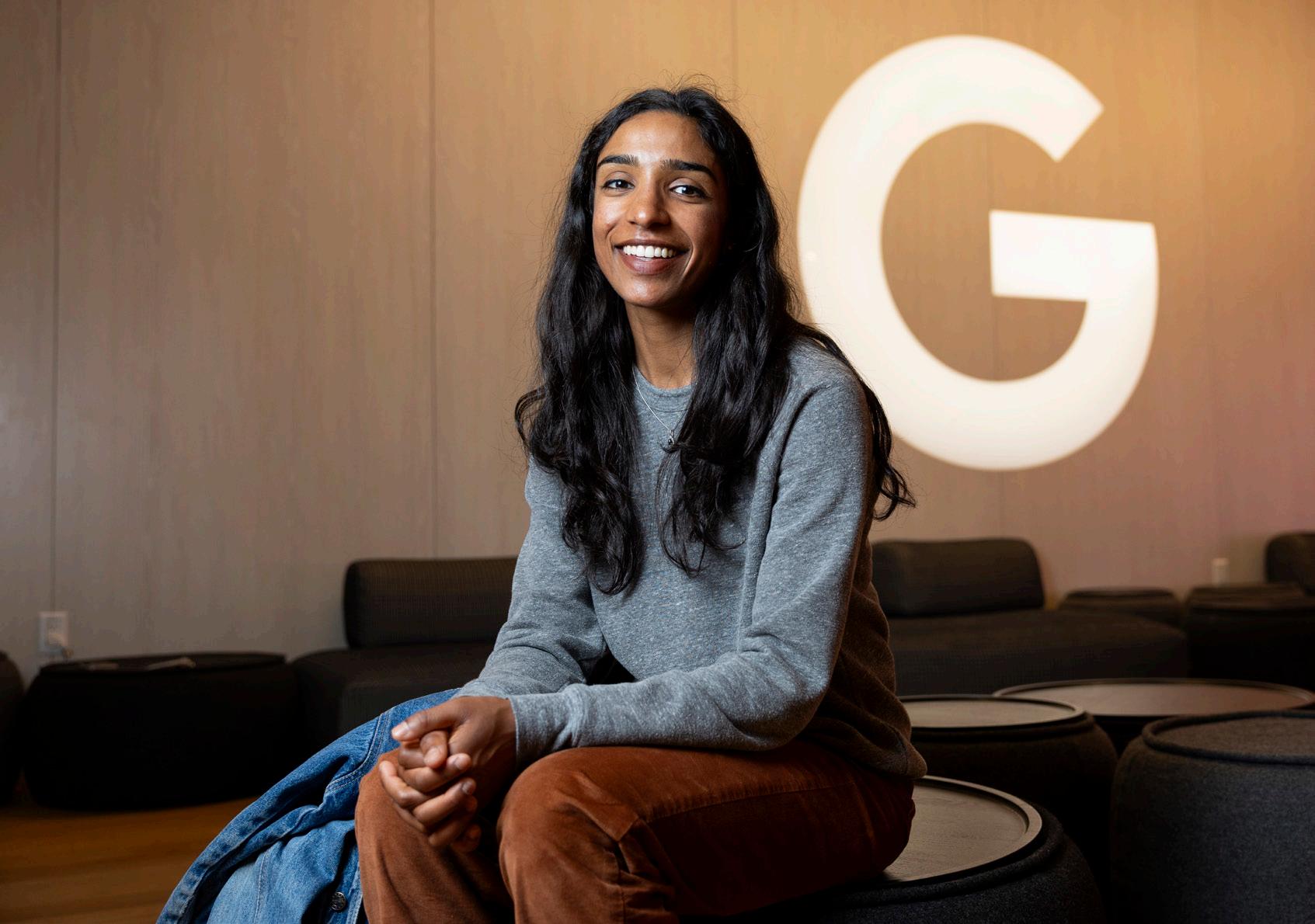
At UCSF, Smitha cares for patients and evaluates which artificial intelligence tools the hospital should adopt to improve workflows and allow clinicians to spend time with their patients.
“When a patient comes into the hospital, often they have a complicated
medical history,” she says, “especially at a place like UCSF.”
Smitha helps implement tools that can summarize pages and pages of notes and medical histories so clinicians have the information they need before meeting with patients.
ANDREW DAVIS TUCKER
ANDREW DAVIS TUCKER
Shreya Ganeshan, Smitha’s younger sister, is a data scientist at Google Photos and Google One. The two live 10 minutes from one another in the Bay Area.
Smitha Ganeshan is a physician and medical director at the University of California, San Francisco.
Smitha BS ’14 and Shreya Ganeshan BS ’18, AB ’18
A Picture’s Worth
One and a half billion. That’s how many people use Google Photos worldwide. Shreya’s job is to use data to improve the product for all those users.
That involves building models and digging into how users interact with the product.
She also experiments with these models to define new metrics and create tools from her findings. But the job is much more than numbers to her.
“I think images are sort of an untapped source of richness about our lives,” she says.
Making those images—full of memories and connections— shareable and accessible enriches people’s lives, she says.
Before landing at Google, Shreya followed her sister to UGA, drawn by Smitha’s experience and the range of activities. Rather than work through an established path like pre-med, Shreya says she used her Foundation Fellowship as an “incubator” to explore ideas. She majored in statistics in Franklin College and economics in the Terry College of Business.
“Developing relationships with professors early catapulted my curiosity about statistics, about using data to solve really thorny problems,” she says.
The sisters feel fortunate to be so close to each other, even if far from Johns Creek. They meet up most weeks, but they’re trying to get one more Ganeshan to San Francisco.
The youngest of the three siblings, Shashank BS ’23, BA ’23, is another Georgia grad and former Foundation Fellow. He’s working at Microsoft in Seattle, but his sisters are intent on luring him down to the Bay.

Learn more about the Ganeshans at: T.UGA.EDU/GANESHANS
Anna Caroline Groff BBA ’24 is an analyst for BrightOrg Services, a management consultant firm based in Atlanta.
Ellie Poindexter Meadows BBA ’24 is an analyst for BrightOrg Services, a management consultant firm based in Atlanta.
Caroline Chitty Morris AB ’24 and Mack Morris AB ’24 got married in 2024. Caroline is a director of advisor engagement with Blue Vault, a Georgia-based investment firm, and Mack is an officer in the U.S. Air Force.
Elisa Fontanillas AB ’24 is an account executive at Saatchi & Saatchi Wellness, a health and wellness communications agency in New York City.
Zack Robbins BBA ’24 works as a development officer on the regional team for UGA Development and Alumni Relations.
Uchenna Onunkwo BBA ’24 has been with the Boston Consulting Group in Houston, TX, for three years, and is now building his own home health company in Athens.
2025
Julian Bolanos BS ’25 is pursuing an MD/MBA dual degree at the University of Maryland School of Medicine and Robert H. Smith School of Business.
Jacob Foster BSME ’25 was accepted into Clemson University’s Master of Science in Bioengineering program and plans to graduate with a thesis in May 2027.
Simline Gijo BSCSE ’25 is a systems engineer I in the rotational engineering leadership development program at RTX.
Daniel Griggs BS ’25 AB ’25 serves as the active planner III in transportation for the Spartanburg County planning department in South Carolina.
Hunter Lanier BBA ’25, BBA ’25 is an analyst with Lanier Realty in Savannah.
Bryce Mandala BSEd ’25 was a field scout for Perfect Game USA, a baseball scouting organization. He now works as a sales associate for DICK’S Sporting Goods in Schaumburg, IL.
Zaire Morgan BSA ’25 is a periodontal surgery dental assistant at Macon Periodontics & Implant Dentistry and is applying to dental school.
Joshua Parry BBA ’25 graduated from the Terry College of Business with a risk management and insurance degree and will pursue a career with Liberty Mutual as an underwriter.
Jack Sims BBA ’25 works for Smurfit Westrock as a supply chain associate in its early career rotational program.
Zach Taylor EdS ’25 was appointed as an instructional technology specialist for the Gainesville City School System in Gainesville, GA.
Jasmine Weathersby-Alexander BSFCS ’25 works as a data entry assistant for UGA EFNEP Extension.
Caroline Wheeler BSHP ’25 moved to London for a six-month cardiac research internship. She will return to Georgia in January to begin the Physician Assistant Master’s Program at Mercer University in Atlanta.
GRADNOTES
ARTS AND SCIENCES
Charles E. Pearson MA ’76, PhD ’79 is an adjunct assistant professor at Hampden-Sydney College in Virginia and a senior archaeologist with Coastal Environments, an environmental consulting firm in Baton Rouge, LA.
Jack Breslin MA ’79 retired from Iona University in New York after 23 years. Before his teaching career, he enjoyed two decades in local and national journalism and public relations, including Fox and NBC.
Amy C. Simes MA ’81 published a history and memoir titled, The House on the Hill of Time, based on Hampden House, where she grew up in England.
Michael Potts PhD ’92 published three books: Learning Latin with Aquinas; Introduction to Scholastic Latin; Learning Greek through Aristotle; and Induction in Psychology and Associated Issues in the Philosophy of Science. Potts is a professor of philosophy at Methodist University in Fayetteville, NC.
Conducting the Ranks
If Don Schofield had never been cut from his eighth grade basketball team, he might not have found his way to the podium of one of the most prestigious musical institutions in the world.
“When I got cut from the team, I realized I wanted to do something where I could find success,” Schofield says. “Band was where I felt at home. I went all in and found the confidence to push further. I thought, ‘Maybe I can do this for a living.’”
Today, Col. Don Schofield BMus ’89 is the 16th commander and conductor of the United States Air Force Band, heading six major ensembles that, collectively, perform nearly 1,600 times a year—from ceremonies at Arlington National Cemetery to international tours that double as acts of cultural diplomacy.
But his journey to this role began in a band room in Gwinnett County. Schofield, a tuba player, excelled in competitions and all-state bands throughout high school and went on to study music education in the Hugh Hodgson School of Music. He was in the Redcoat Band, which is where he also met his wife, Laura Wood Schofield BMus ’90
“The faculty at Georgia made me feel important and valued,” he says. “Those years gave me the foundation, musically and personally, for everything that came after.”

After completing his master’s degree at Louisiana State University, he found a job teaching high school band in Effingham County and thought he had found his calling. But a friend encouraged him to audition for a conducting role with the Air Force Band, an idea he initially dismissed as out of reach.
“These were the bands producing recordings I grew up listening to as a model of what an excellent band is,” he says. “I thought, ‘There’s no way I could do that.’”
He auditioned anyway and aced it. Then he turned the position down, unwilling to abandon his students in
Written by Ireland Hayes AB ’23
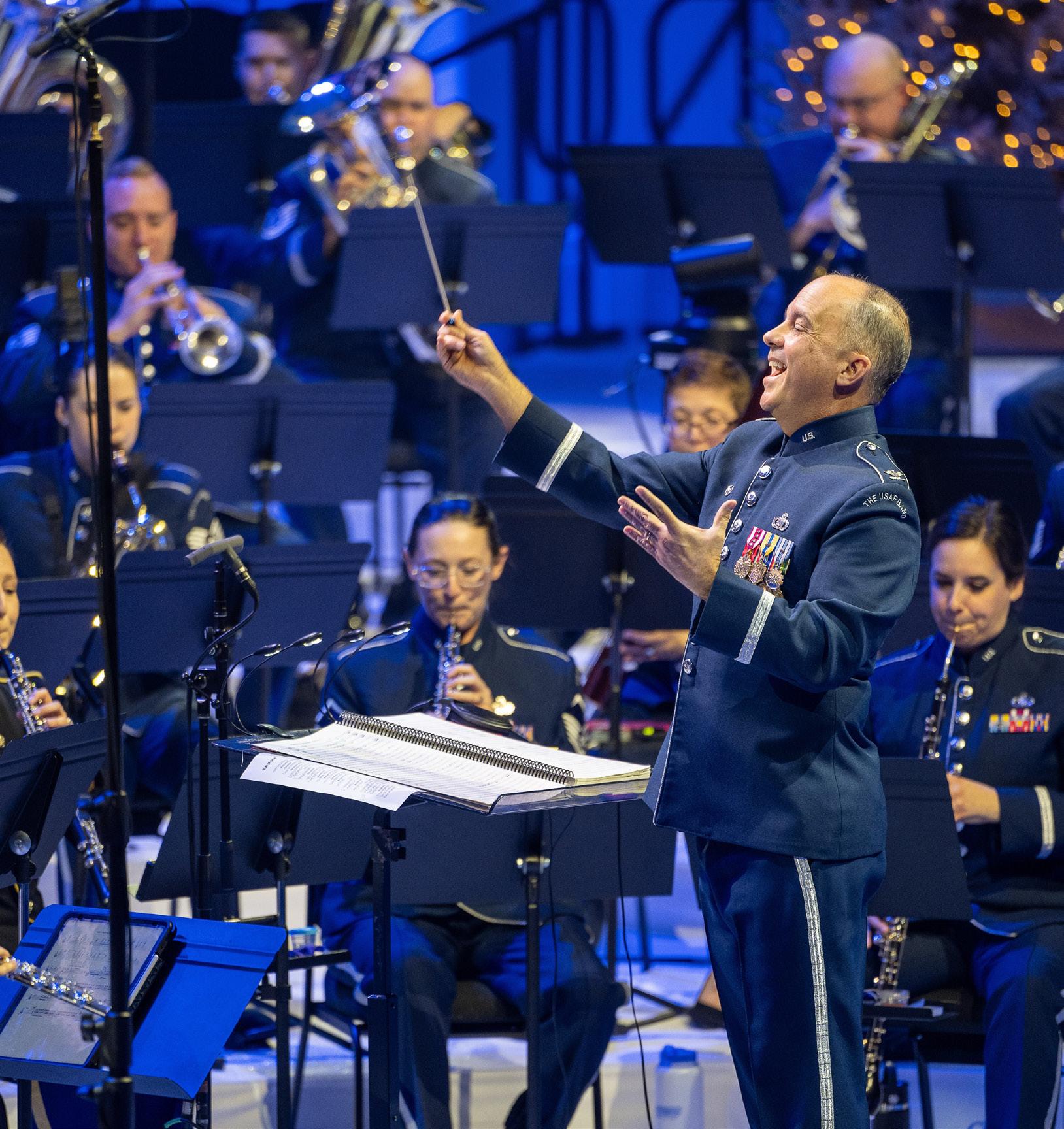
Effingham just as the school year was beginning.
But the Pentagon called back.
Officials offered Schofield a delayed enlistment. And he and Laura decided to take the leap of faith.
“It was an adventure that no one we knew had ever had,” he says. “I didn’t plan for military service, but sometimes opportunity is where luck and preparation meet.”
Since then, Schofield’s career has taken him around the globe, from performances at the White House and schools in Brazil to sold-out stadiums in Scotland. In
2019, President Donald Trump awarded Schofield and the Air Force Band the National Medal of Arts, the highest honor given to artists and patrons of the arts by the United States government.
Schofield’s passion goes beyond perfect performances and is rooted in a belief that music connects people. Success isn’t measured in flawless notes, he says, but in whether a bridge is built between the performers and the listeners, making a lasting bond.
“Did that family at Arlington feel comfort? Did that foreign dignitary want to keep the conversation going? Does that relationship last past the music?” Schofield says. “If so, then we’ve done our job.”
As a UGA student, Don Schofield played in the Redcoat Marching Band. Now a colonel in the USAF, he is the conductor of the United States Air Force Band, which received the National Medal of the Arts under his baton.
Don Schofield BMus ’89
IRELANDHAYES
Debra Bourdeau PhD ’04 was named vice provost of online learning and educational innovation at Missouri University of Science and Technology. George Felis PhD ’09 is an academic advisor for UGA’s College of Engineering. Nathan Dixon PhD ’23 is the winner of the 13th annual BOA Editions’ Short Fiction Prize for his collection, Radical Red Katie Galyon MA ’23 is pursuing a doctoral degree in Spanish linguistics at the University of Texas.
Han Lou PhD ’25 is a postdoc at Beijing International Center for Mathematical Research.
Laura Vieira PhD ’25 is a Spanish teacher at Clarke Central High School in Athens.
BUSINESS
John Dinsmore MBA ’03 is a marketing professor at Wright State University in Michigan. He published the book The Marketing of Debt: How They Get You.
EDUCATION
Qiana Williams EdS ’10 released her debut romance novel, Crossing Lines at City Hall, under the pen name Charese Powell. Wagner Pierre MEd ’12 has taught middle school for more than 20 years in the U.S., Dubai, China, and Guam. He currently teaches in Germany.
SOCIAL WORK
Joel Gross MSW ’73 is spending part of his retirement as a volunteer bailiff at the Dunwoody Municipal Court.
VETERINARY MEDICINE
Dr. Thomas Richter DMV ’77 has worked as a veterinarian for nearly 50 years.
KEEP UP WITH THE BULLDOG NATION
ADVERTISE IN Georgia Magazine
Published quarterly and mailed to the household, your advertising message reaches your audience directly, giving you one of the strongest demographic buys in the region. For information on advertising in the award-winning Georgia Magazine, contact gmsales@uga.edu or 706-542-9877.
SEND US YOUR NOTES
Help the Bulldog Nation—and especially your classmates—keep up with what’s happening in your personal and professional life. Send us a Class Note!
You can send us notes in two ways: 1. Through the UGA Alumni website or 2. By email directly to Georgia Magazine
We will run your note in the first available issue. We receive a lot of notes (thank you!) and really appreciate your patience. It may take a few months for your note to appear, and we may need to edit them for length and/or clarity. When submitting a note, please include your current mailing address.
TWO WAYS TO SEND CLASS NOTES:
Through the UGA Division of Development and Alumni Relations: alumni.uga.edu/classnote
Email Georgia Magazine: gmeditor@uga.edu
Lance Palmer
Janette McGarity Barber Professor COLLEGE OF FAMILY AND CONSUMER SCIENCES
Astudent volunteer came to Lance Palmer with a burning question: How do you tell someone they owed thousands in back taxes?
Palmer directs the University of Georgia’s Volunteer Income Tax Assistance (VITA) program, a free tax preparation service run by IRS-certified financial planning, accounting, and finance students.
It provides a hands-on service-learning opportunity, allowing students to interact with clients under the guidance of UGA financial planning faculty like Palmer. One lesson he teaches students: Be honest and transparent with clients, even when it seems difficult.
“Oh, thank goodness!” one client said. “I thought it would be so much more!”
The initiative is just one way Palmer is helping people better manage their finances—Sydney Barrilleaux BS ’24
Why does financial education matter?
Financial knowledge and being confident in your financial decisions and goals is associated with many positive personal and family outcomes that go beyond dollars and cents. In many situations, people are misinformed about the tax law or misunderstand other financial principles, and this can negatively impact their decision-making process.
That’s why we launched the Financial Resilience and Education Center. It focuses on creating experiential learning opportunities for UGA students to provide highimpact financial services and education to the community, including high school financial education and literacy.
Why include students in VITA?
Students want to gain experience. Sometimes, they’ve never had a professional job.
It’s also a great opportunity for the students to learn how to show empathy to their client, if their expectations were dashed by the changes in the tax law or in their own family situation. You meet clients whose spouses died that year and they’re grieving, but they still have to talk about their income and filing that final joint tax return.
There are a lot of opportunities for growth and experience for students in this program.

Endowed chairs—positions that receive supplemental support generated from private donations—are essential to recruiting and retaining leading faculty who are committed to world-changing research and preparing the next generation of problemsolvers, pioneers, and leaders. Learn more about supporting UGA’s leading faculty at GIVE.UGA.EDU
DOROTHY KOPZLOWSKI
From recent grads and established professionals to those seeking a new direction, we are
DAWGS, ALL CAREER LONG.

TURN TO THE UGA CAREER CENTER FOR
• Monthly career and leadership development webinars.
• Job search and graduate school bootcamps.
• Monthly job search strategy sessions.
• One-on-one coaching appointments.
• Asynchronous resume reviews.




